Versailles: Part One
|
Story written by Rick Archer
May 2014
Rick Archer's Note: At the end of Marla's
2014 Rhone River
cruise along France's Rhône and Saône,
we made a stop in Paris.
On our second
day, we made a visit to Versailles, the former capital of
France until the French Revolution. Part One
covers the story of our trip to Versailles as well as some
of the history behind the Palace. Part Two is
the incredible story of
Marie Antoinette.
|
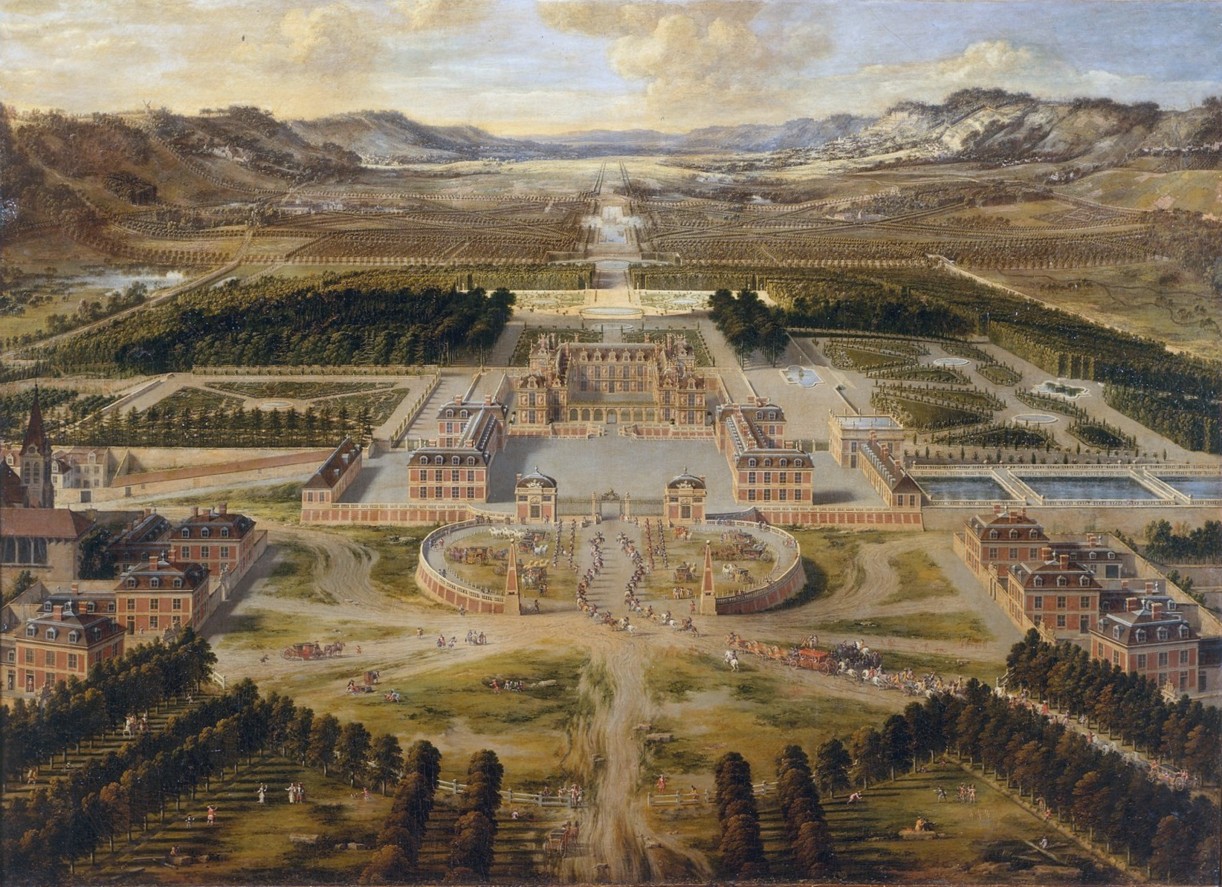
|
|
|
Rick
and Marla's Trip to Versailles
|
Rick's Note: I have seen
Paradise.
And its name is Versailles.
On April 22, the final day of our 2014 Rhone River Cruise,
Marla and I visited Versailles.
This visit was beyond a doubt my favorite
moment of this adventure-filled, action-packed river cruise
vacation.
The land for the Palace of Versailles was bought by
French King Louis XIII. The Palace was built by French King
Louis XIV. It resides in a forest 9 miles southwest of the
Eiffel Tower in Paris.
When the château
was first built, Versailles was a country village. Today it
is a wealthy suburb of Paris.
The court of
Versailles became the center of political power in France in
1682 when Louis XIV moved his entourage from Paris out to
this new Palace in the country.
Versailles
served as the Royal Palace until October 1789 when the royal
family was forced to return to the capital after the
beginning of the French Revolution.
|
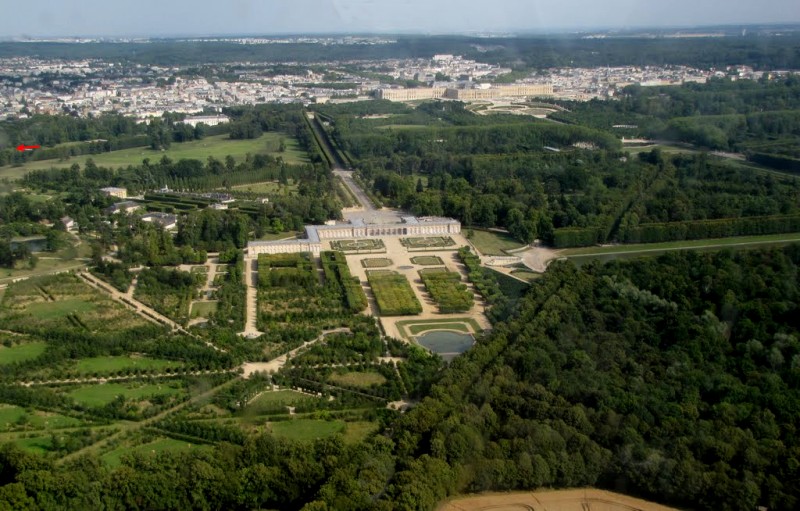
In this picture, we are looking at the
Palace of Versailles from the back. In front, you can
see the Paris suburb of Versailles. Far in the
distance is Paris itself 9 miles away.
The
first part of our bike journey took place on a country road
marked by the red arrow.
|
Today Versailles is famous not only as a
building and a fascinating place to visit, but as a lasting symbol of the now despised system
of absolute monarchy in the 'Ancien Régime'.
It is almost
impossible to list all the things I liked about our trip to Versailles, but
I will take a stab nevertheless. I will be writing
both about our experience and throw in a generous amount of
18th century French history for good measure.
It was
Marla who came up with the idea. She did some research and came up with an interesting tour
of Versailles that involved bicycles. Over the past year,
Marla and I had been intentionally walking an hour a day
just so we could get in shape for an all-day activity like
this.
When Marla
brought up the idea of using a bike tour to cross the
grounds of what was described on the Internet as an "unusually large
estate", I was immediately on board.
Using a company called "Flat Tire", oops change
that to "Fat Tire", Marla noticed the office
was within walking distance of our Concorde Opéra
Hotel next to Gare
Saint Lazare train station.
So on the final
morning of our trip, Marla and I started our 3 mile journey
through the streets of Paris.
Along the way we
crossed the Champs-Élysées, one of the most famous
streets in the world.
|

Marla
at a park near Champs-Élysées
|
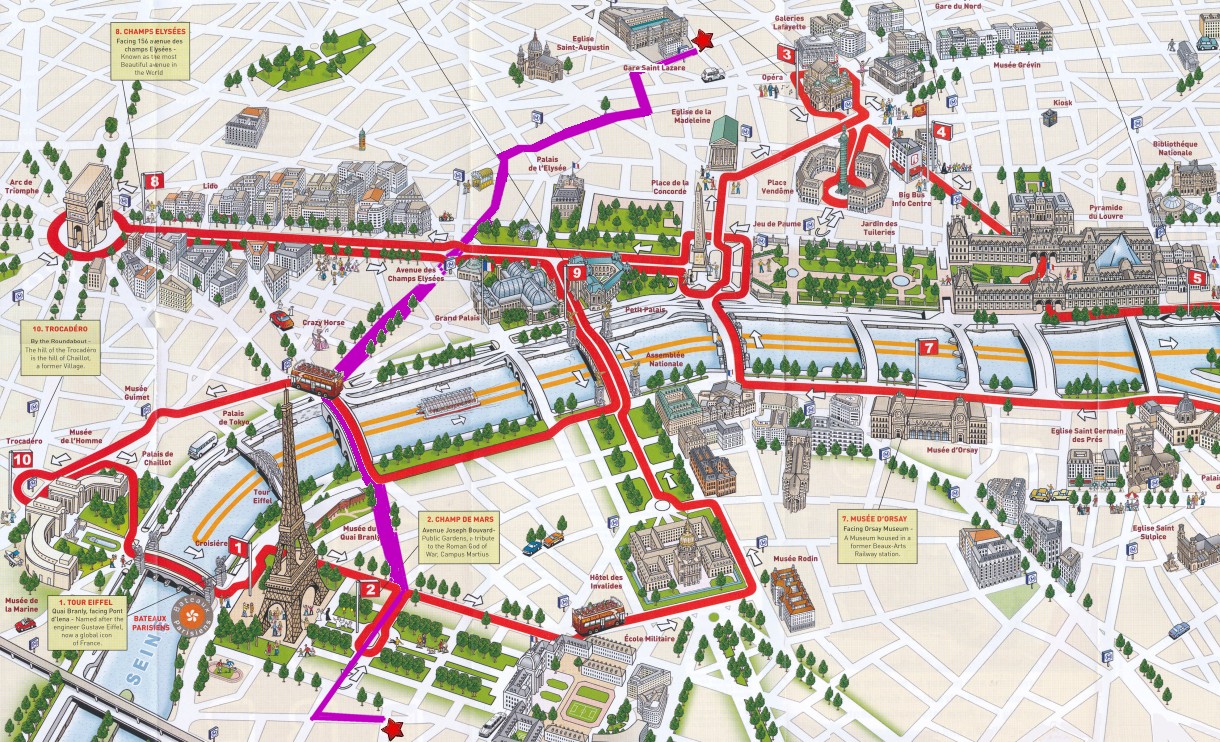
I hope
the Hop On - Hop Off people don't mind if I use their
attractive map. The
PURPLE
LINE
is our walking route from the Concorde Opera Hotel next to
the train station to the Fat Tire office.
|
I had a favorite street. Its name was Avenue Montaigne,
home base to some of the most famous brands in the world.
Along the way we passed the entrances to Dior, Ralph Lauren,
Chanel, Prada, Ferragamo, Louis Vuitton, Jimmy Choo,
Givenchy, Armani, Escada… and these were just the names I
recognized. Marla knew many of the other names as well. It
was fun to be surrounded by these icons of the fashion
industry.
|
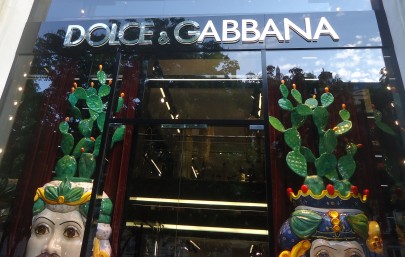 |
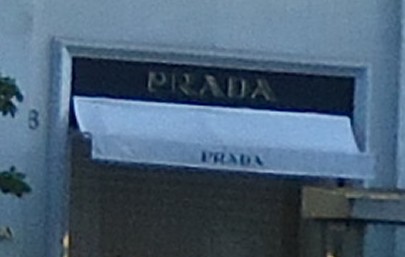 |
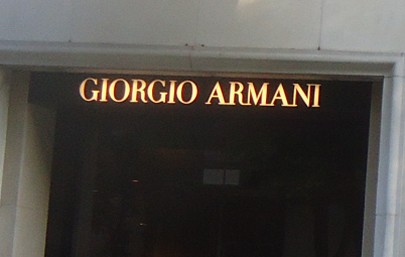 |
| |
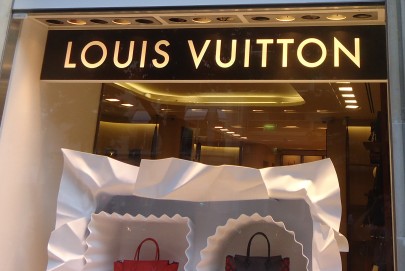 |
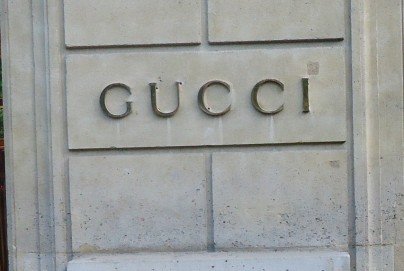 |
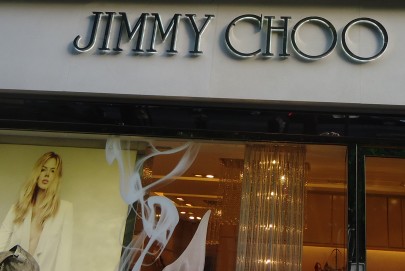 |
| |
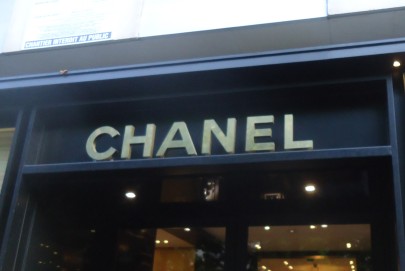 |
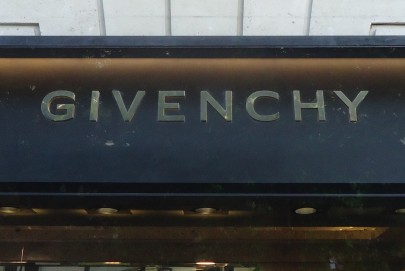 |
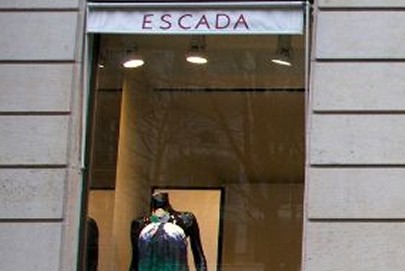 |
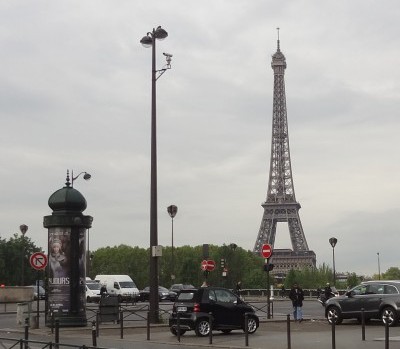 |
We crossed the
Seine River and walked right past the enormous Eiffel Tower.
Everywhere we
looked we were surrounded by statues, landmarks, famous
buildings, exquisite architecture, and beautiful
landscaping. It was a marvelous adventure… and just the
start of things to come.
From the Fat
Tire office, we walked another half mile and hopped on the
Metro subway train which whisked us to Versailles.
After a quick 20
minute ride, we were at the town of Versailles.
|
 |
Then we took a short ten minute walk to pick up our bikes in
an office next to a giant cathedral. By chance, I noticed an
abandoned nerf ball stuck under a parked car, so I kicked it
onto the cathedral square.
I had just gotten my bike, so while I was waiting for the
other people to get their bikes, I looked up.
I grinned when I saw
a tiny terrier had discovered the ball. The dog was
happy beyond happy as he strutted
around the square showing off his prized possession.
I could not
believe that dog had the nerve to think he owned that ball.
Hey, dog, that's MY BALL! I had seen that ball first, so I went over to
reclaim my trophy.
Wrong. That dog wouldn't let me anywhere
near that ball. I never even came close, but I didn't
care.
At first the
poor French lady who owned the dog was perplexed by my
behavior. Judging by her expression, I am sure she was
worried I was going to hurt her poor little dog. But
once she saw I had absolutely no chance of catching the
shifty little dog, she began to grin instead. I
suspect she enjoyed seeing her dog put 'le crazy Americaine'
in his place.
The two of us
played a delightful game of keepaway complete with my
demands to "give me the ball!" and the cute dog's growls of
"come and get it, slowpoke!"
The dog won. He was
really quick!
Of course long
ago when I was a boy, my entire life revolved around my bike
and my dog. I may be 64 now, but somewhere in the back
of my mind I still think I'm a kid.
Gosh I had fun playing with that dog!
|
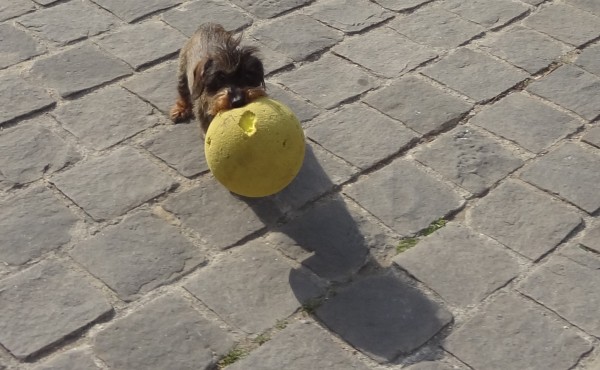
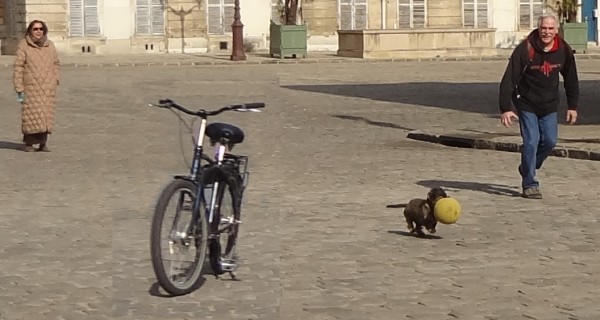 |
Now it was time
to hop on my bike and head off with the pack. What a joy it
was to be on a bike again! I rode my bicycle to school for
six solid years rain or shine back when I was a kid… which
is exactly what I felt like riding this fat-tired,
three-speed clunker. It was practically the same bike I had
grown up with!
Our next move
was a stroke of pure genius. The Flat Tire Versailles
experience would include a picnic lunch in the afternoon.
Even better, we got to select our own meal!
We rode our bike to a huge farmer's market. There on three
of the four corners we found fresh fruit, recently picked
vegetables, cheese, bread and pastry, wine… every kind of
food imaginable. Costigan, our guide, told us to roam around
and pick out what we wanted for a picnic lunch.
Costigan gave us
a secret word - goûter - which meant "to taste". He said the
merchants would be more than happy to let us sample the food
because it usually led to a sale.
Marla and I had a delightful time strolling around the
market place. Now I came upon the grapes. Which ones to buy,
green or red? I decided to use my secret word. "goûter,
goûter!!"
The guy just stared at me in disgust. Finally, shaking his
head the whole time, he handed me all of two grapes… one
red, one green. Mind you, there were hundreds of loose
grapes laying around wherever the eye could see, but I got
all of two free grapes.
Based on my
highly limited sample, I chose the green grapes. However, I
was very disappointed at how poorly my goûter trick had
worked out for me.
Finally Marla and I finished our shopping spree with a
bottle of white wine. I couldn't help but notice the total of 20 euros, wine and all, had added up to the least expensive
meal we had purchased all week. Interesting.
|
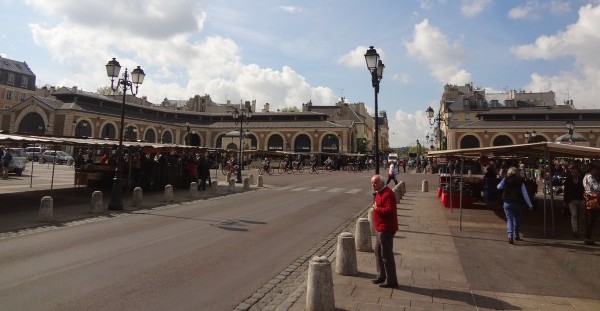
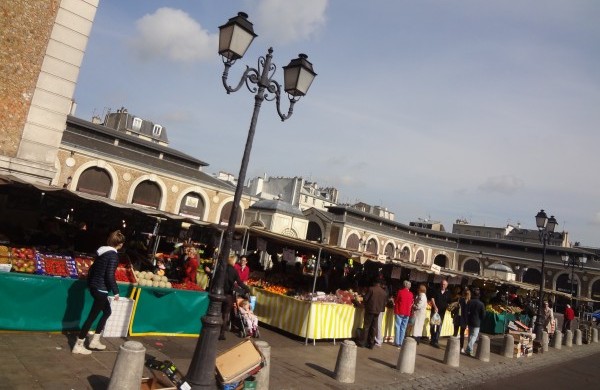 |
 |
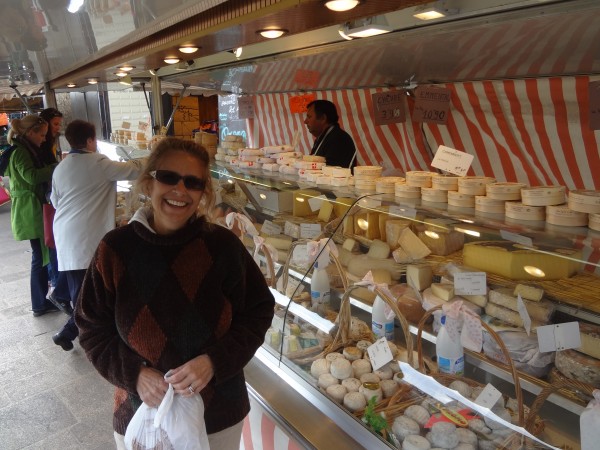 |
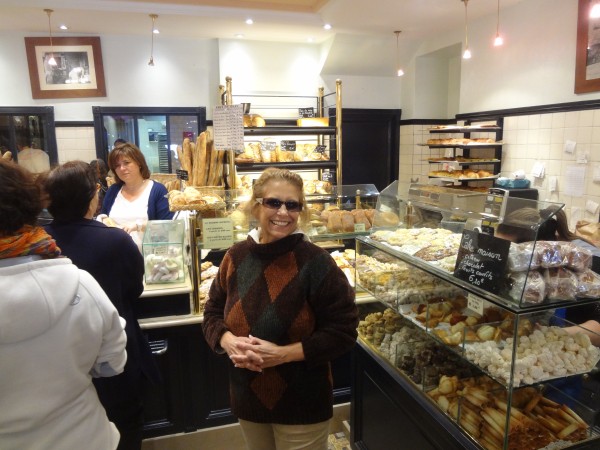 |
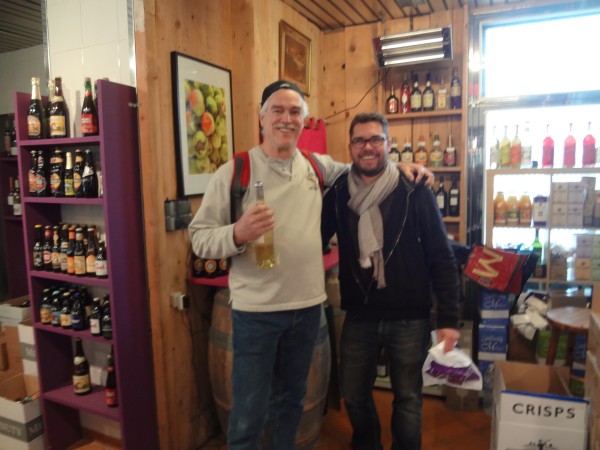 |
So now we reconvened at our meeting place. I asked Costigan
what I done wrong with the grapes. Costigan laughed and said
my pronunciation was so terrible, surely the merchant was
too offended to be generous. Gee, thanks a lot!
I had time to wash
off my grapes. Then I carefully placed our goodies in the
bike basket I had been given to carry our picnic lunch. This
whole picnic idea was just too cool.
While I waited
for the rest of the pack, I noticed a young lady working
with our bikes. I imagined this
pretty girl had to be extremely lonely, so I went over to
chat with her. Her name was Claudia. She was
putting air in our tires to make sure the
Fat Tire didn't turn into the Flat tire.
I found out that
Claudia was one of the tour guides as well. She said she had been
trained by Costigan and raved about his sense of humor.
I had also thought he was funny until he made fun of my French
pronunciation. Now I didn't like him anymore.
I asked Claudia
where she was from. It turns out Claudia came from
Cuba of all places. I raised an eyebrow. I told
her I had
never met anyone from Cuba before.
Claudia smiled
and nodded. She said lots of people tell her that. Her father was a diplomat who
decided to take his family with him on a trip to Ecuador
when Claudia was very young.
Her Dad liked
Ecuador so much, he decided to stay. Claudia added her
father still doesn't known why the officials ever dreamed of
allowing the entire family to travel together. To this
day, that lucky break remains the "Great Family Mystery".
Now we headed
over to the Palace grounds. You may notice there are
no other bikes in the picture on the right. That's
because I was the last one there. I had stayed behind
to take one more picture, so that put me at the back of the
pack.
Costigan had
taught us to spread out and use the entire half of the
street to prevent any cars from even thinking of going
around us. He termed this technique "Domination" of
the road.
Well, being the
last person in the group, a car came up right on my back
wheel and suddenly honked its horn. I swear I almost
fell over from fright. The sound took me totally off
guard. So I pulled aside and let the car through. It
made a right turn at the corner. I estimate the car
saved 10 seconds in the process.
Later I admitted
to Costigan my shame at letting a car dominate me instead.
He shook his head in chagrin. "There's always one slow
buffalo in every herd. We lose more customers that
way."
I think he was
kidding. Maybe not. Now I didn't like him
anymore.
We rode our bikes down a lovely
dirt country road with wooden fences.
The Palace
grounds were nothing short of Paradise. There were tall
majestic trees, wide fields with horses, goats, and sheep,
rolling hills on the perimeter, and thick green grass in
every direction. And don't let me forget to mention the
spring wild flowers. It was so peaceful!
After half an hour of riding around the grounds, Costigan
pulled us over for a long chat under the trees. We put our
bikes down, sat on the grass in the shade and listened as
Costigan proceeded to share the history of Versailles.
In 1575, the
domain of Versailles was bought by Albert de Gondi, a
wealthy merchant from
Italy. Gondi invited King Louis XIII on several hunting
trips in the forests surrounding Versailles.
Noting the
forest was teeming with game and pleased with
the location, Louis ordered the construction of his own hunting
lodge in 1624.
Eight years
later, Louis XIII obtained the domain of Versailles from the
Gondi family for himself. Now he began to make a few enlargements to the château.
This structure would become the spot where the new palace
would be built.
However, it
would be his son Louis XIV who decided to turn the land into one
of the largest palaces in the world. Once it was
finished, the entire French court was invited to come live
with Louis XIV either in the Palace itself or in the
surrounding neighborhood. This was the new seat of
government.
|
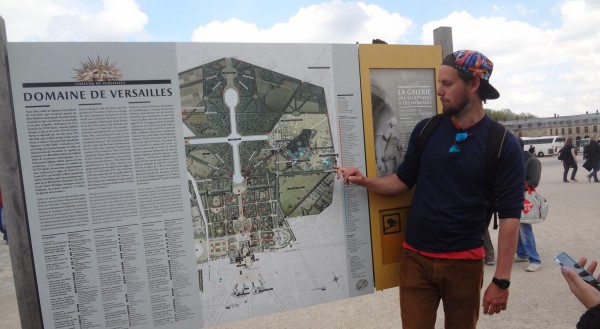
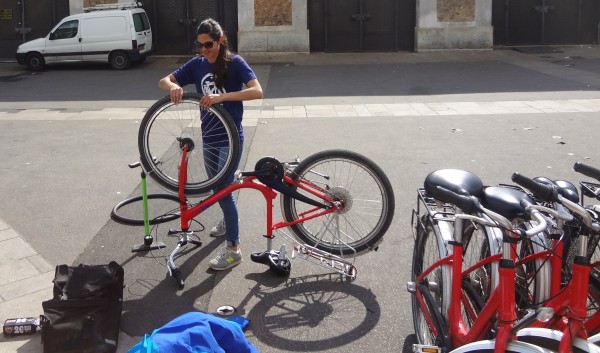
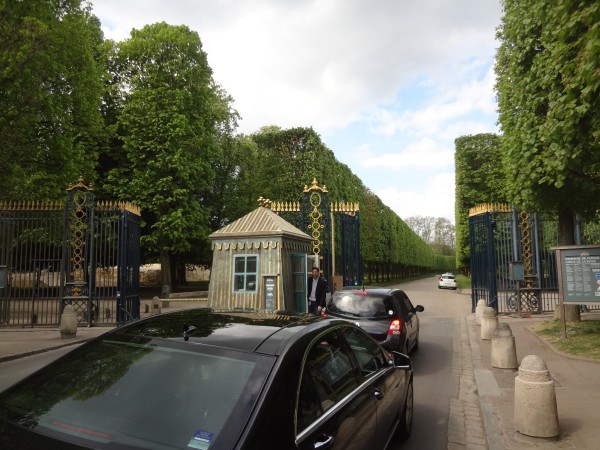
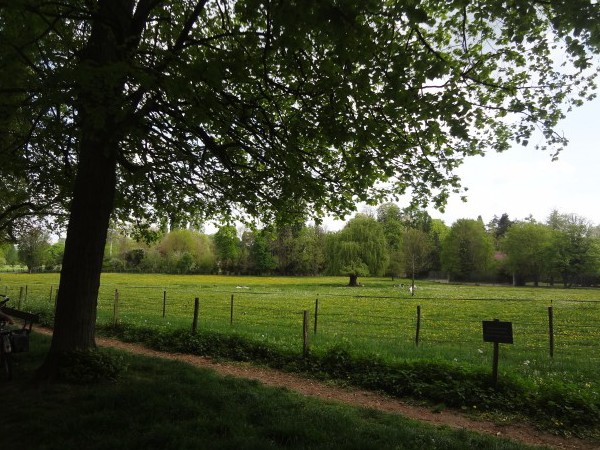 |
Louis
XIII and Louis IV, Father and Son
|
Despite his
mean tendency to have fun at my expense, I quickly realized Costigan was an extremely gifted tour guide. There's a
chance his actual name is "David Costigan", but he
preferred to have us call him 'Costigan', so we did.
I learned
Costigan
came to Paris from New Zealand to be with his girlfriend, a
French girl he had met in New Zealand. Costigan may just have
been the best tour guide I have ever had. I could have
listened to him for hours. Hmm, now that I think of it, I
did listen to him for hours.
Costigan
explained that Louis XIII had left France in pretty good
shape. France had dominated Germany in the Thirty
Years War and had gained vast new territory in the New World
as well.
Costigan said
that Louis himself wasn't really that great a king. Instead
he was quite fortunate to have Cardinal Richelieu to
run the affairs of state so Louis could go hunting instead.
Apparently the
classic novel The Three Musketeers took place in
these times. Louis XIII, his wife Anne, and Cardinal
Richelieu all became central figures in Alexandre Dumas'
famous novel. The book depicts Louis as a man willing to
have Richelieu as a powerful advisor but aware of his
scheming; Louis is portrayed as a bored and sour man, dwarfed
by Richelieu's intellect.
These were great
times for France which was at the height of its power.
However there was one big problem - no heir.
Four babies in a
row had been stillborn. Much blame was heaped upon
Queen Anne for her failure. Suddenly after 19 years of
failure, a child
was born. It was a boy!!
The country went
wild with joy. Finally there was a successor.
After 19 years of trying, this good fortune was so improbable
that it was compared to the Virgin Birth of Christ.
All thanks were directed to the Virgin Mary for her divine
intervention in creating this wonderful and quite unexpected miracle.
The cynics said
otherwise. Louis XIII, a suspected homosexual, was
more likely the problem. Those in the know suspected
Anne had decided to change the person shooting the bullets.
No matter.
Louis XIII was happy, so that's all that mattered.
From this point on, the son Louis XIV had every possible
gift and permission heaped upon him. The boy grew up
believing he could have anything in the world he desired.
The young man was so spoiled he assumed the world revolved
around him.
Costigan began
to smile. He said the extravagance of Versailles was
unimaginable. He explained the cost to build the place was
so great that the entire population of France was heavily
taxed in order to pay the bills. He added the State treasury
was virtually empty once it was done.
That didn't
bother Louis XIV a bit. He was called the 'Sun King'
because he assumed the entire word revolved around him.
He was so heavily insulated from the people he had no idea
that people suffered so he could build his trophy home.
Or if he did know, he didn't care.
"I am the Sun
King. I can do anything."
No one knows the
exact cost to build Versailles, but it has been estimated
that it would cost over $2 billion to build in modern times.
I didn't particularly care for the Palace itself because it
was so crowded thanks to the Easter weekend, but based on what I did see, I can easily
believe the price tag.
Indeed, Louis XIV, the fabled Sun King, felt like he was God
on Earth. The world revolved around him; he believed
whatever he wanted, he could have. Unfortunately, he nearly
broke France's back in building Versailles, an act that
sowed the preliminary seeds for the French Rebellion.
|
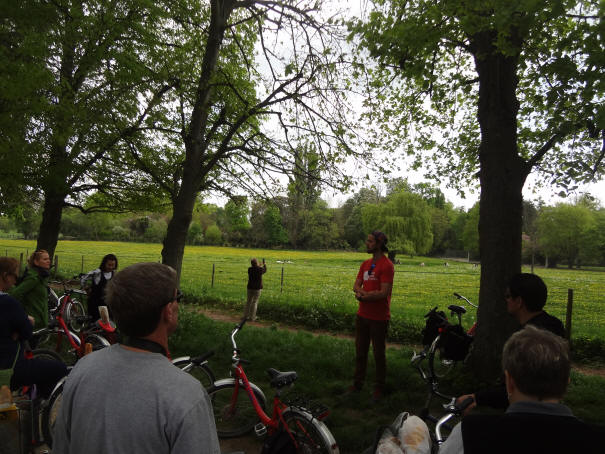

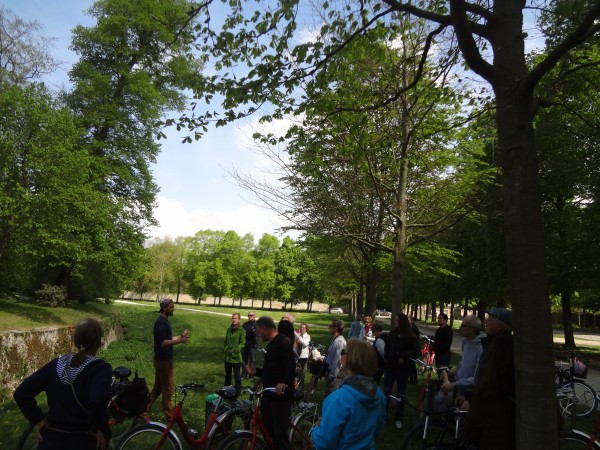
The
master at work. Costigan had me spellbound.
|
|
|
|
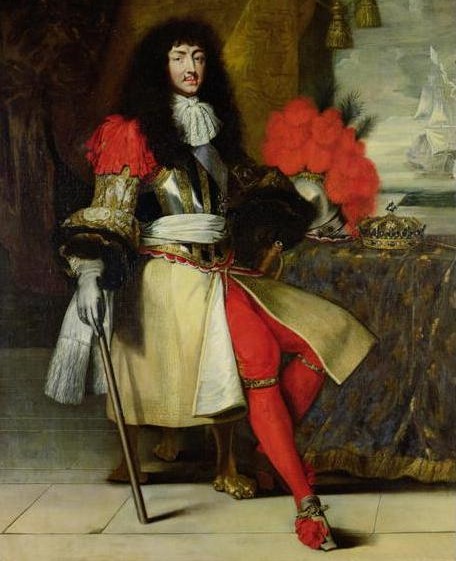
Louis XIII
(1601-1643), House of Bourbon |
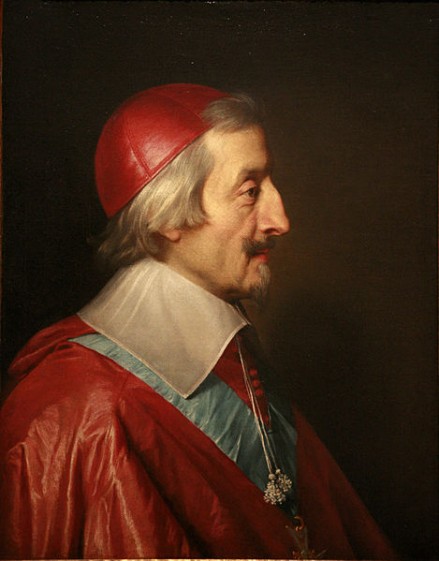
Cardinal
Richelieu, right hand man to Louis XIII |
|
|
|
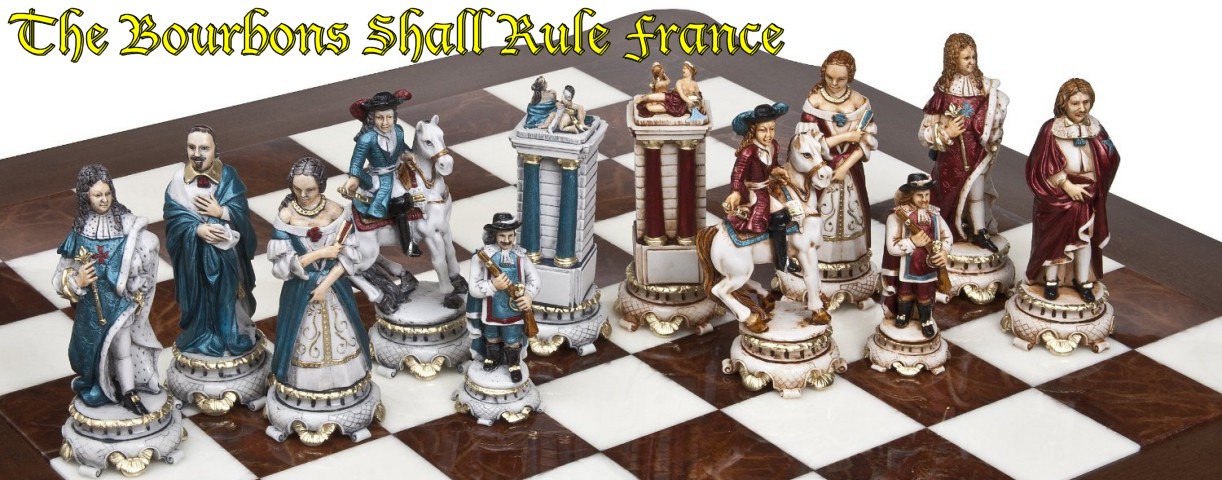
France was at the height of its powers under Louis XIII.
That would change swiftly. The next two kids were definite
bad boys. |
|
|
|
|
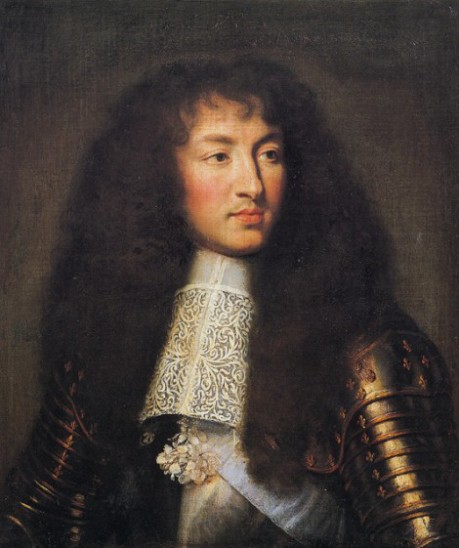
Louis XIV
(1638-1715), House of Bourbon |
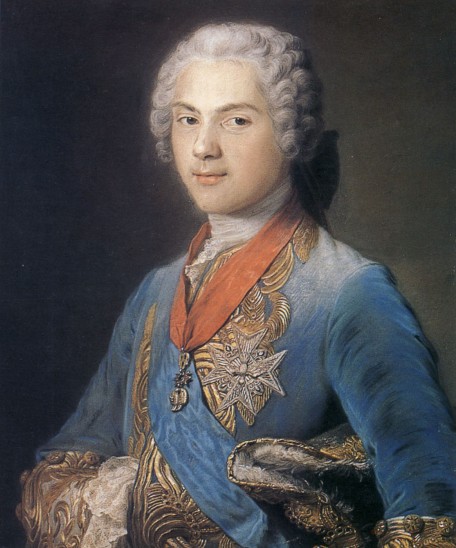
Louis XV
(1710-1774), House of Bourbon |
| |
|
Grand
Trianon
|
|
|
|
After Louis XIV
finished building his Palace, he "invited" all the nobles to
follow him out to Versailles.
In other words, if these
nobles wanted to continue to be important, they had little
choice but move out there themselves.
It was said that
Peter the Great of Russia pulled the identical trick.
After the completion of the grand city of Saint Petersburg,
Peter ordered all the nobles to move out of Moscow "or else".
Peter the Great
had built a splendid palace of his own on the banks of the Gulf
of Finland. The first visitors gasped at its beauty and spaciousness.
Then one world
traveler made an interesting observation. "It looks
just like Versailles. What a
coincidence!"
Indeed, this new "Peterhof"
did look a lot
like that palace at Versailles. A friend quickly
suggested the man keep his thoughts to himself.
This was no
accident. Peterhof was a deliberate copy of the
Palace of Versailles. And why was that?
|
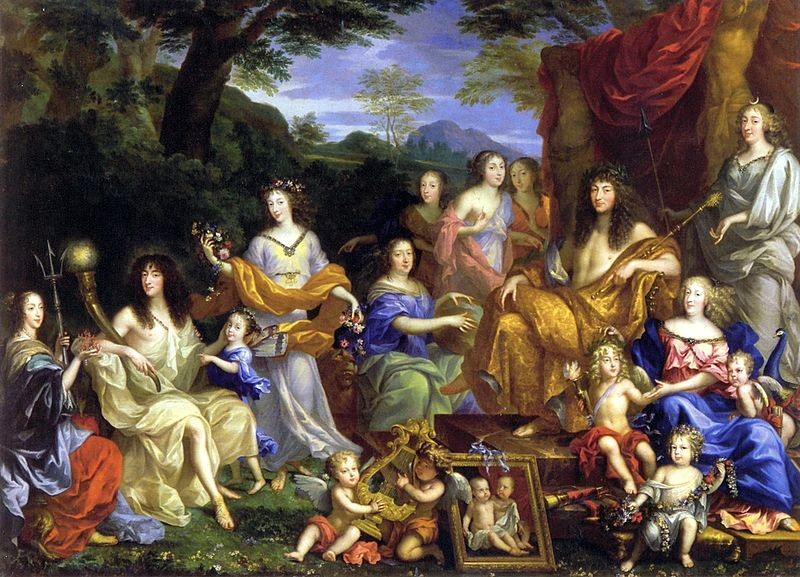
In this
picture, Louis XIV is depicted as a Roman God along with the members
of his family.
It must be
nice to have such a healthy self-esteem
|
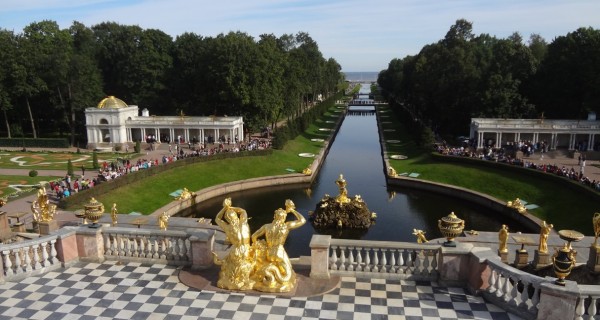
Here is Peter the Great's
Peterhof.
Some say it is even prettier than Versailles.
I kind of agree. But Peter had the advantage of copying the
finest Palace ever built. I think elevating the
Peterhof Palace
was a great idea. It made everything - the fountains,
the statues and Peter's version of the
Grand Canal
even more
impressive.
|
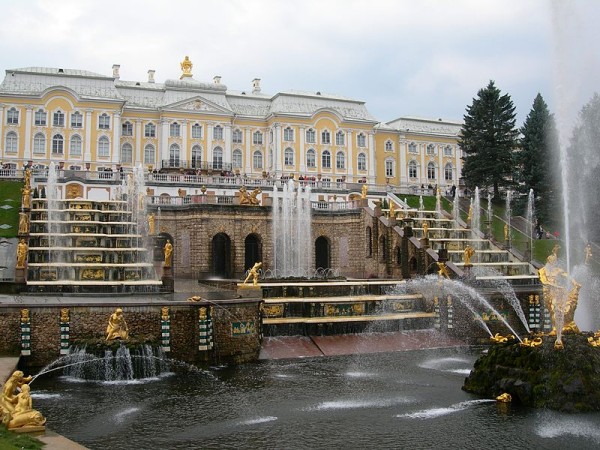 |
|
|
|
|
When Peter the
Great (1672-1725) came to power, it was his goal
to force 'modernization' onto Russia. However, he needed ideas,
so in 1697 he embarked on an 18-month scouting mission.
Peter wanted to see the latest developments in Western
Europe and perhaps copy them back home.
One country
fascinated him in particular: France. He wasn't alone.
Everyone in Russia was infatuated with France and its
sophistication and culture. However, a sudden
rebellion took place back home. Rushing back
immediately, Peter's greatest disappointment had been missing
his
chance to see France.
The stated
reason for Peter's 1717 visit to France was diplomacy. The
Regent sought closer Franco-Russian ties. However, Peter had
an important additional agenda in mind.
Construction on
Peterhof, Peter's own estate, had begun on a modest scale in
1714. However, before building his own Grand Palace, Peter
wanted to take a close look at Versailles first.
Versailles was at the top of Peter's list of places to see.
In June 1717, Peter was put up in the
Trianon-sous-bois, a wing of the Grand Trianon for a
week's stay.
Some girls were provided for his pleasure. How
thoughtful! Taking sketches in the daytime and
studying curves at night, Peter is
said to have had the time of his life. Seeing how
France and Russia had warm relations from that point on,
Peter's trip to Versailles was a success.
When Peter
returned home, he had plenty of suggestions for his
architect. Now construction on Peterhof began in earnest.
(I wrote a story about
Peterhof in 2012 complete with pictures).
So what was this
"Grand Trianon"?
Grand Trianon was an afterthought of Louis XIV, the Sun
King. After all the important people of Paris followed
his suggestion and moved to Versailles, Louis XIV realized
he wasn't lonely any more. In fact, he had more company than he
could stand. He had wanted his court to be close, but not
this close.
Louis IV began
to crave a little privacy. So in 1668 he purchased the
small village of Trianon about a mile and a half away and
had it demolished. In this spot, Louis built yet
ANOTHER PALACE and made it his private estate.
Truly, if no one
had shown me the Grand Palace first, the Grand Trianon
Palace would have easily fooled me into thinking it was the
main event. It is quite "Grand" in its own way.
|
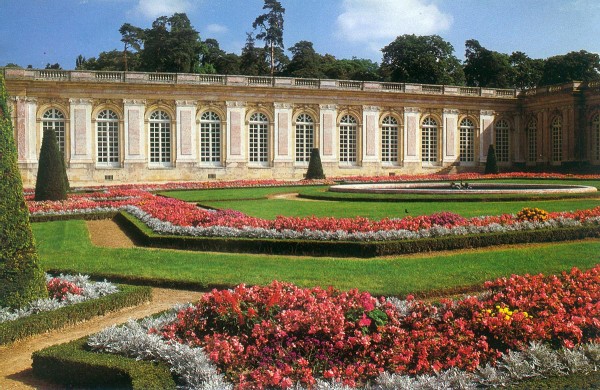
Grand
Trianon
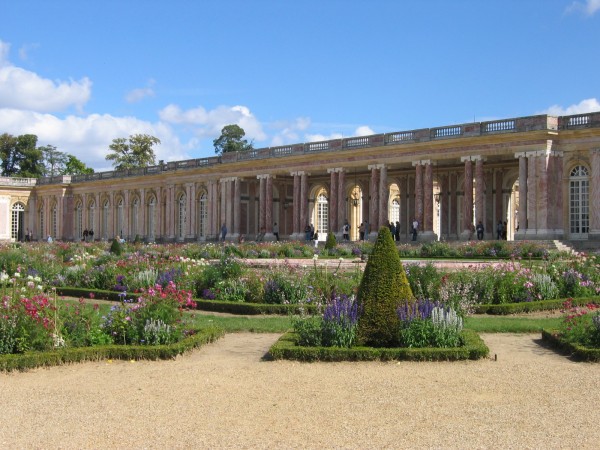
|
|
|
|
Madame
Montespan!!
|
|
|
|
So what did
Louis IV have in mind with Grand Trianon? The
King had built a love nest here. Louis installed
one of the most famous mistresses of all time, Francois Athénaïs de Montespan, better known
Madame de Montespan.
In this day and
age, a mistress had no need to hide. Indeed, there was
even a position in high court for such a woman.
It is sad to
point out that in French history, the mistresses were
usually much more interesting than the wives. The main
role of the Queens was to provide babies, 'heirs' if you
prefer. Typically the Queen was chosen for the King;
he had little or no say so in the matter. If a warmth
developed, excellent, but all that really mattered was to
have children.
A mistress, on
the other hand, was someone chosen by the King. This
is where his heart... or passion ... really lay.
Typically the King was far more interested in his mistress
than his wife.
Madame de
Montespan became the celebrated 'maîtresse en titre'
(mistress of title) of King Louis XIV of France, by whom she
had seven children.
Born into one of
the oldest noble families of France, Madame de Montespan led
a very eventful and colorful life. She was considered
the true Queen of France by some due to the pervasiveness of
her influence at court during that time.
Married herself
to the Marquess de Montespan, she bore the man two children.
Apparently the couple had gotten right to work after the
wedding. She soon
became pregnant with her first child Christine. Two
weeks after her daughter's birth she danced in a Court
Ballet. A year later her second child was
born.
With her
child-birthing duties handled, Montespan turned her eyes to
bigger game. She quickly established herself as the
"reigning beauty of the court". Beauty was only one of
Madame de Montespan's many charms. She was a cultured and
amusing conversationalist. In addition, she kept abreast of
political events. This had the effect of making her even
more appealing to men of intellect and power. Montespan was
courted by a number of high-born suitors.
By 1666, two
years after the birth of her second child, Madame de
Montespan was busy trying to take the place of Louise de La Vallière, Louis XIV's current mistress. Using her wit and
charm, Montespan sought to ingratiate herself with the king.
Her so-called "reign"
began in 1667, when she
first danced with Louis XIV at a ball hosted by the king's
younger brother, Philippe I, Duke of Orléans, at the Louvre
Palace. Montespan was a bit conspicuous in her
attempts to make an impression.
Louis XIV and Louise de La Vallière knew full well that
Montespan was trying to conquer the King's heart. Louis
simply laughed at her miserably excessive effort and Louise
thought the woman a clown. However the young mistress
Louise had definitely underestimated this new rival.
Montespan
managed to become
friends with both Louise and French Queen Maria Teresa. At a
time when both the Queen and Louise were pregnant, they requested that Madame de Montespan help them entertain the King during private
dinners.
Both women
quickly regretted their request as Montespan
entertained Louis perhaps a bit too enthusiastically.
To conceal his
new relationship, Louis placed the two ladies in rooms connected
to his. This gave the King access to both. Able to
compare the women in every way imaginable, Louis chose Montespan. Humiliated, Louise joined a convent, the
typical place of refuge in France for jilted women.
The spotlight
now belonged to Athenais de
Montespan, 25. Montespan proceeded to become the ultimate baby
machine.
To make a long
story short, Louis tried to have his children by Montespan legitimized.
This brought the Roman Catholic Church into the picture.
Due to her role in royal adultery, the Roman Catholic Church
soon became her adversary. In 1675, the priest Lécuyer
refused to give her absolution, which was necessary for her
to take Easter communion, a requisite for all Catholics.
Father Lécuyer
raged, "Is this the Madame that scandalizes all of France?
Go abandon your shocking life and then come throw yourself
at the feet of the ministers of Jesus Christ."
During this
time, there were clear indications that Louis XIV was losing
interest in Montespan. A legion of serious contenders
were being auditioned by Louis in his so-called "Pleasure
Palace" at Grand Trianon.
Montespan wasn't
pleased. Legend suggests Montespan resorted to black magic in order to get
the King
back to her bed.
Le Affaire des Poisons
erupted in September 1677. This sordid tale was the beginning of the end of
the reign of La Montespan. The scandal began when a
woman on the fringe of French court admitted she had
poisoned her father and two brothers in order to inherit
their estate. The sensational trial drew attention to
a number of other mysterious deaths. This started some
wild rumors of rampant use of poison. Prominent people, including Louis XIV, became
alarmed that they might also be poisoned.
The police were
given permission to cast a wide net to get to the bottom of
these rumors. At one point, the police interrogated a
confessed poisoner Marie Bosse who pointed
the finger at another poisoner La Voison who in turn
pointed her nasty finger at none other than Madame de Montespan.
Before La Voison
was beheaded in 1680, the convicted witch exclaimed
vehemently that Montespan had bought aphrodisiacs
and performed black masses with her in order to regain the king's favor over rival lovers.
Scandalous!!
Once Montespan
was accused of consorting with the notorious La Voison,
even more rumors starting flying. One rumor stated a police
investigation uncovered the remains of 2,500 infants in La Voisin's garden. Unbelievable. Another rumor had
Montespan stripped naked while conducting a black mass ritual to
make her more desirable. Whatever the truth, the Affair of
the Poisons placed murder, infanticide, and satanism right
at the doorstep of the Court of Louis XIV.
In the end, the
Affair of the Poisons caused much hysteria. In that
regard, it is sometimes compared to Salem
Village. The Poison Affair implicated 442 suspects.
367 orders of arrests were issued, of which 218 were carried
out. Of the condemned, 36 were executed; five were sentenced
to the galleys; and 23 forced into exile. It was a very
serious matter.
Owing to her
position, Montespan was never charged. However, from
this point on she was always under suspicion. Now something
strange happened - a woman in court died suddenly. Due to
the circumstances, this death
made people believe even more that Madame de Montespan was capable of murder.
The King's eye had strayed to another
beauty, the Duchess of Fontanges. Marie Angélique de
Scorailles was said to be the newest most beautiful woman in the
French court.
Marie was quite
the trophy indeed. The moment
Marie's
family realized their daughter was a real prize, they decided
to capitalize. Using the asset of her great beauty, they raised enough
money to send her to court. If Marie could make it to
the royal bed, this was their best chance
to replenish the family coffers. Therefore when Marie caught the biggest fish of all, her parents were
so proud their gamble had worked like a charm.
Yes, indeed,
Marie had become Louis' latest Mistress du jour.
Now Madame
de Montespan was relegated to the position of superintendent
of the Queen's household. Big step down!
When it became known the
Duchess Marie was pregnant, this brought matters to a head. Montespan was heard to say she was going to kill the...,
well, fill in the blank.
Before any more
developments in her rival's romance could
occur, Mlle de Fontanges died suddenly in 1681. The
poor girl was only 20 at the time. Members of the
French Court immediately suspected the young woman had been poisoned by Montespan.
Poison had been around for a long time, but proving its use
was difficult. There were two methods of detection: autopsy or obtaining
a confession by torture.
Interestingly,
the King forbade an autopsy. And
no one was going to torture Montespan without the King's
consent. Consequently
Montespan was never charged. It was suggested that
perhaps Louis had obstructed any investigation to avoid
bringing scandal to his court.
Now
another rumor arose that Montespan had even been poisoning
the King. One would think that particular rumor would make it a little
tough for Montespan to hang on to her lover. Not
Montespan. Maybe she did have mysterious powers!
Despite all the
rumors and the scandal which had forced Louis XIV and
Madame de Montespan publicly apart, the king continued to visit her
daily in her room at the Grand Palace.
Apparently her
brilliance, charm, and spirited conversation were more than
enough to overcome her reduced status as a discarded mistress.
Montespan had
originally come to prominence by overtaking a rival who
underestimated her. Curiously, the same thing happened
to her. Françoise d'Aubigné was about to leave town to
put her life back together when she met Montespan. On
the spot, Montespan hired Françoise to become her nanny.
Over the next
eight years, Louis came to respect the job Françoise had
done raising his army of illegitimate children. Then
he fell in love with the woman... Montespan was out of favor
due to the Mistress Code: Live by the bed, die by the bed.
|
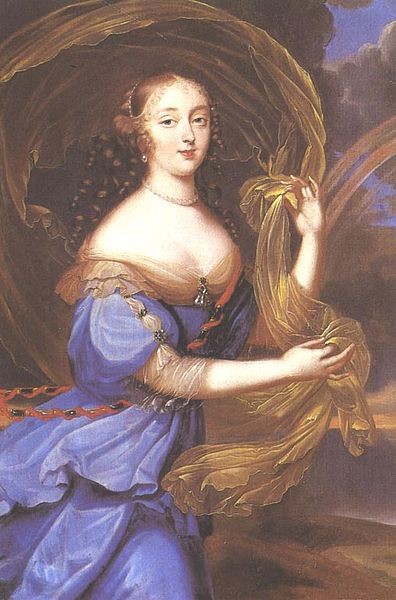
Madame de
Montespan
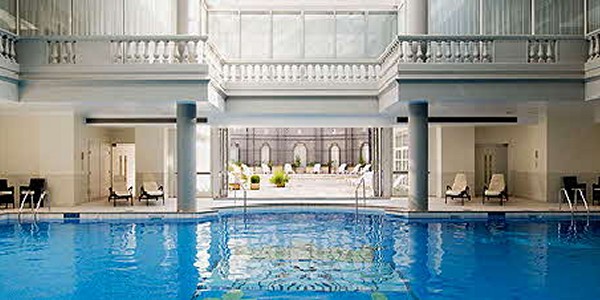
Louis
XIV's Pleasure Palace included a swimming pool
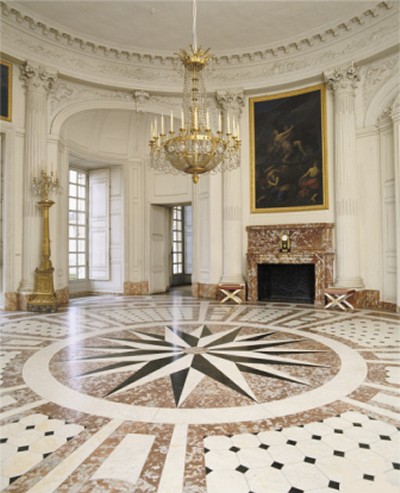
The lovely
Round Room at Grand Trianon
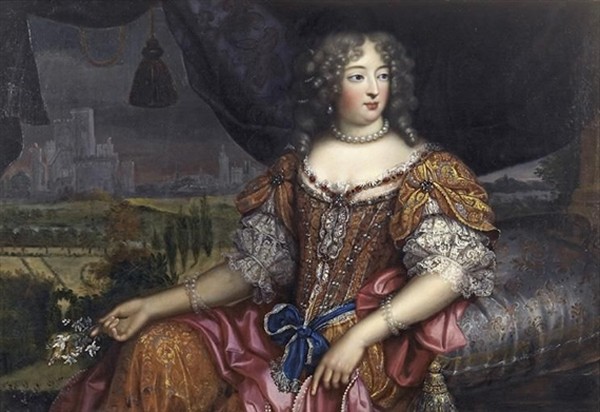
Montespan
- the things some girls will do to hang on to their man
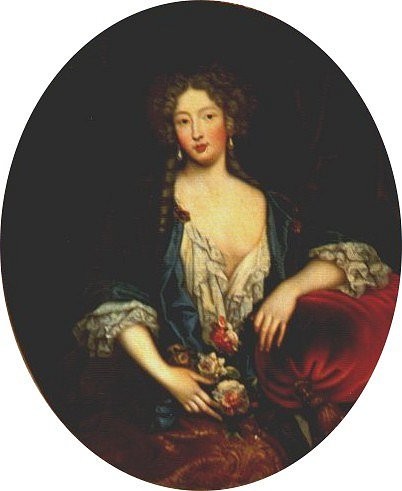
Marie
Angélique de Scorailles, better known as the Duchess of
Fontanges
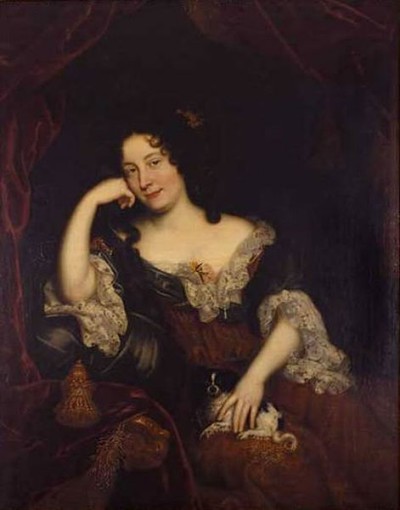
Françoise
d'Aubigné, Marquise de Maintenon
She was
introduced to court by none other than Montespan who stared in
horror when her friend turned into another rival.
Obviously the position of 'mistress' in Louis' court was a
precarious post indeed.
Maintenon
not only became first
a Royal Mistress of Louis IV, she eventually became his second wife...
except that she was poor. So
Louis and Maintenon kept their marriage a secret.
|
|
|
|
Rick's Note: During our visit to
Versailles, Costigan alluded to some pretty strange events
at the "Pleasure Palace". However he admitted his
hands were tied by the presence of a 16 year old girl in our
midst. There was some stuff he just couldn't talk
about openly.
I asked a couple
questions, but all Costigan said was, "When you get home,
remember to Google 'Grand Trianon'. You won't believe
some of the stuff that comes up."
He was right, I
did have a hard time believing a lot of the stuff
I read. The main impression I came away with is that
rumors had great power in France of the middle ages.
In the Court of Louis IV, there were almost as many rumors
as there were mistresses.
I had another question
for Costigan. I asked him if he knew how large France is
compared to some of the states in America.
He replied, "France is
almost identical in size to your state of Texas."
I laughed. "How did you
know I was from Texas?"
He grinned and pointed
to the Houston Rockets pullover I was wearing. "Isn't Houston a city in
Texas?"
Hmm. Good point. I felt
sheepish that I hadn't figured that one out myself.
|
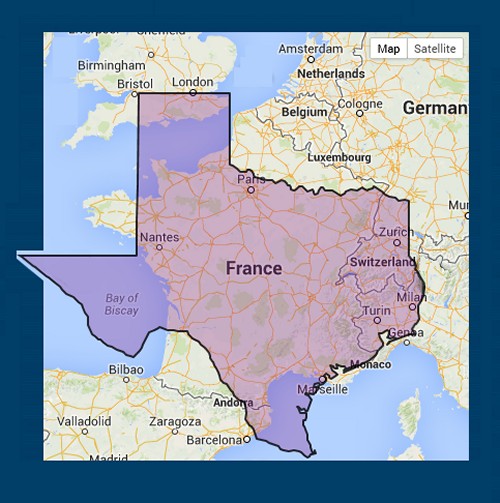 |
Costigan and I were
clearly kindred spirits. The things that interested him
interested me. Plus he had a similar teasing sense of humor.
For example, just when
we had finished getting our bikes and were ready to take off, some
lady realized she had left a bag in a nearby park area. As we waited in the Cathedral Square for
her to retrieve her
bag, it was
obvious some people were impatient with her forgetfulness.
Costigan said, "Well, it
looks like we have a couple extra moments here in case any of you
would like go over and say confession (he gestured towards
the church about 30 yards away). Oops, maybe not. Judging from the guilty
looks on your faces, we don't have two hours to spare."
Indeed, a couple people
had clearly blanched at his first suggestion. A guilty
conscience perhaps? I don't think they
appreciated his comeback either. But I did. It is so
much easier to appreciate good humor when the teasing is
directed at someone besides me, the 'slowest buffalo'.
|
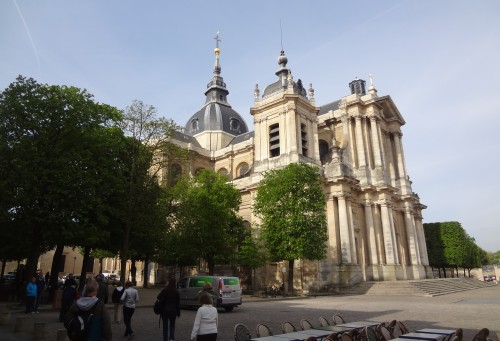 |
|
|
|
Louis XV
|
|
|
|
When it came to
philandering, Louis XV was far worse than his father.
Not only that, but
at least Louis XIV had some talent as a King.
Not his son Louis XV. He had none.
Louis XV was good at only one thing, womanizing
and luxury.
Costigan suggested Louis XV spent most of his
time over at the "Pleasure Palace" on the edge of the
Versailles estate with his legion of mistresses and various
wives of members of the court.
Costigan smiled and explained that back in those days it was
a real break to have one's wife selected for the King's bed
since it promised many favors to come. He implied that
since the royal bed was seen as a stepping stone to more exalted
positions in society, husbands were more open-minded
about this activity than our astonished group might have
guessed.
If a couple
wished to be a member of Louis XV's Royal Court, the
entrance fee was typically a night with the King.
"O Yes, King,
certainly,
please sleep with my wife.
Thank you so much! What an
honor this is for our family to see you take my wife into your
bed! It is my hope that you enjoy her charms
thoroughly. We are so completely grateful, Sire,
for this grand privilege."
The popularity of Louis XV was threatened by the public exposure of
his marital infidelities. After all, his wife Queen
Marie Leszczynska was highly respected and much loved by the
French people. The Queen refused all cliques and acted
above board in every way... in stark contrast to her
philandering husband. The average French citizen would
have been appalled at how their gracious Queen Marie was
treated by Louis.
However, Louis
was upset at her failure to produce a good supply of male
children (only one male child, the Dauphin Louis, survived
among her many offspring).
This was a
pretty mean thing to say. After all, the woman had
tried as hard she could. Marie had borne Louis 10 children!
At some point the queen simply gave up trying to please the
man and sought refuge in religion and charities.
The king could have cared less. He took mistresses, a recognized practice at the time.
The
designation 'maîtresse-en-titre' ("official mistress") was
an elevated court position that was sometimes retained even
after the king and mistress ceased being lovers.
On a personal note, I found myself squirming at these
revelations. American society has a totally different
attitude towards marriage and fidelity. It made me
uncomfortable at hearing this foreign approach to sensitive matters
as these.
However, at the
same time, I was interested to learn how a society
such as France had once dealt with these issues. By studying
different cultures and different attitudes, I broaden my
perspective accordingly. It is called 'worldliness'.
I was dying to
ask Costigan if he thought if the so-called open-minded French attitudes towards sexual
matters could be traced directly to the behavior of their
royals centuries ago. However, I never got the chance.
As for Louis XV, one of history's greatest libertines, he made very good
use of his Pleasure Palace. In the 1730s, Louis began a
series of love affairs with four sisters of the Mailly-Nesle
family. Costigan didn't say whether it was one sister at a
time or all 4 at once.
Then there was
Madame du Barry, Madame de Pompadour, and also Marie-Louise
O'Murphy de Boisfaily. All these women were highly prominent
in French society.
And these are just some of the names. There were plenty
more. The King felt he could do whatever he liked
whether French society approved or not
The sixty year
reign of Louis took place back in the days when the salons
of Versailles were filled with beautiful women and society
was just now freeing itself of the moral constraints of the
previous century.
At first I was
judgmental, but then I remembered a period of history here
in America known as the Swinging Seventies. If America could
experiment with its own sexual revolution, then this
was France's 18th Century version of the same thing.
As a leader,
Louis was popular enough until he led France into the
disastrous Seven Year War with Britain. Rather than
pay attention as his Empire
dwindled and his treasury emptied, Louis amused himself with
a series of scandalous love affairs.
The enemies of
Louis decided the easiest way to hurt him would be to reveal
his debauchery with rumors. My, how the
tongues twittered when it was revealed the King had set up his own private
brothel in the gardens of his palace and bedded four sisters
from the same aristocratic family. Tsk tsk tsk.
Louis fathered at least 30 illegitimate children in addition to
his 10 legitimate children. He even had the nerve to bring
his favorite mistress - the glamorous and brilliant Madame
Pompadour - into sharing the power of government.
What is weird
about reading the stories of Louis XIII, Louis XIV, and
Louis V is that their wives get so little mention. It
seems like the mistresses got more publicity than the wives.
Had Louis XV done anything of note to advance France,
perhaps his infidelities might have been overlooked. But
Louis XV didn't accomplish much of anything.
Costigan said, "Historians have depicted Louis XV as one of
the weakest of the Bourbon dynasty, a do-nothing king who
left affairs of state to ministers while indulging in his
hobbies of gaming and womanizing. Louie spent years
and years hunting for deers and dears."
Costigan added that it was on his watch that Prussia made
huge gains in Europe while Louis XV did little to keep this
dangerous nation in check when he had the opportunity. It's
tough to worry about military matters when you can't even
roll out of bed.
While Costigan
continued, I listened to the young man with unabashed joy.
For the past ten days, I had listened to one female guide
after another. No questions about it, these lady guides were quite talented. I know
the ladies in our river cruise group clearly loved them because they told
me so.
However, I have
to confess
they left me a bit bored at times. It was clearly a Mars and
Venus thing. There were times I simply could not fake
further interest in the exact curve of a particular cornice
or listening to a description of a King's attire in 1303.
Not Costigan. He was pure Mars.
He talked about boy stuff…
politics, wars, balance of power, murder, womanizing, scandals,
bedroom gossip, palace intrigue, social unrest, execution, and the
historical impact of each ruler involved with Versailles.
I
listened to the young man's every word with an excitement
that bordered upon hero worship. As a history buff, I
was fascinated all day long. Can you tell?
|
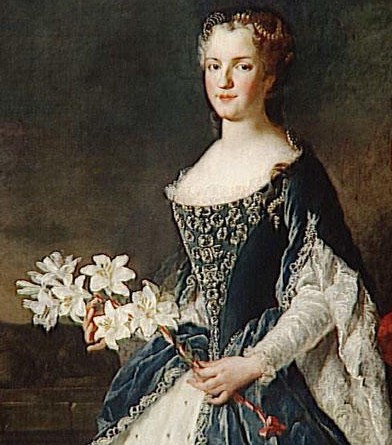
Maria
Leszczynska, Queen of Louis XV
She was widely admired by the people and greatly neglected by
the King
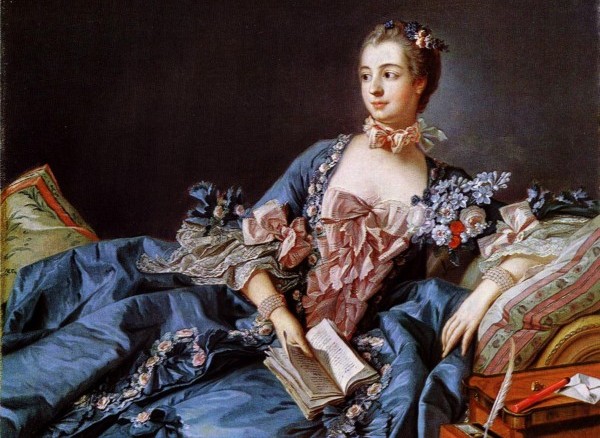
Madame
Pompadour
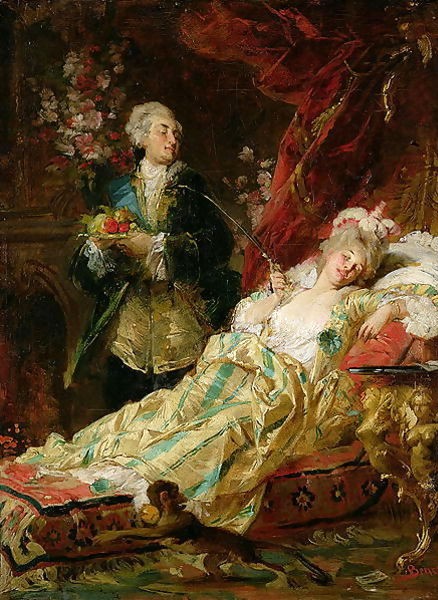
Louis XV,
the parasite who would be King, appearing at the
side of his mistress, the voluptuous Madame Du Barry,
a woman said to thoroughly enjoy pleasure
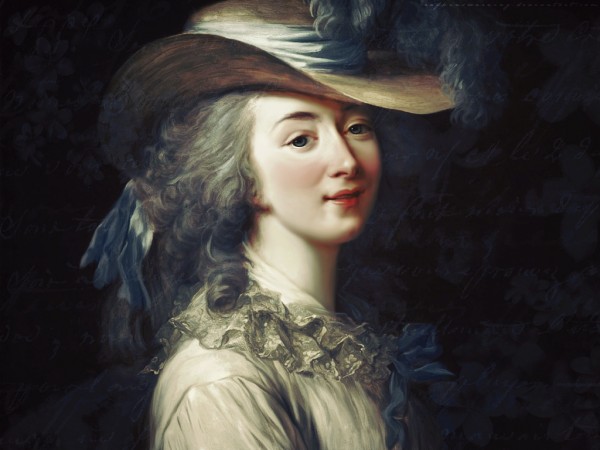
Another
look at Madame Du
Barry
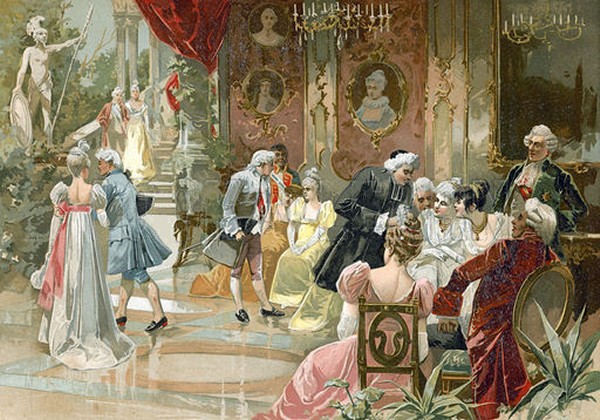
|
| |
|
Petite Trianon
|
|
|
|
At
the end of his story about Marie
Antoinette, Costigan pointed to a nearby ditch.
I was well aware of
this ditch, having fed a piece of bread to a duck
wandering over from the shallow water.
Costigan
explained that this ditch was in a reality a moat of sorts.
It was not meant as a defensive barrier since it would be
fairly easy for anyone in our group to cross if they cared
to.
Instead it was meant as a symbolic separation between
Petite Trianon, Marie Antoinette’s private cottage retreat,
and the massive Grand Palace a mile away.
Now Costigan
smiled and asked us to study the trees on either side of the
ditch. He asked if anyone noticed a difference. Once he
pointed it out, the difference was obvious to all of us.
On
the Palace side, the majestic trees were lined in a perfect
row along the country road. They had been pruned in a
highly distinctive manner and stood at attention like
identical soldiers under review.
Costigan said
this orderly design was the French way of demonstrating
man’s mastery over nature. Considering I had seen this
exact same design on many streets of Paris and other parts
of France during the trip, I came to understand that this
elaborate trimming of trees to an exact
pattern was actually a well-established
French custom.
Now Costigan
turned our attention to the trees on the other side of the
ditch/moat. They were very lovely, but none of us noticed
anything special about them. Then someone said they didn’t
match. And they weren’t planted in a row. Costigan
nodded. Exactly. These trees had been planted as a show of
rebellion on Marie Antoinette’s part.
When Louis XIV
had given her this small slice of the vast estate to do as
she pleased, Antoinette’s first inclination was to plant her
trees in the English “natural style”. In other words, the
trees had a “deliberate randomness” to them.
Now Costigan
smiled and apologized for the use of the odd phrase “deliberate
randomness” with a straight face. I grinned. This guy had
a great sense of humor.
In other words,
Marie Antoinette was sick and tired of being told how to do
things the “French Way”. She had actually used her
non-linear landscaping as a way to thumb her nose at the
French court in Versailles.
Costigan shared
an anecdote. One day as Antoinette walked the grounds, she
noticed two trees growing side by side.
Antoinette was
immediately suspicious. Had someone deliberately
planted these trees in
an orderly way?
Upon questioning,
the gardener explained that both trees were “volunteers”,
having sprouted up from the seeds of a nearby tree.
Unconvinced, Antoinette
ordered that one of two trees be cut down immediately. She
simply could not bear the thought of any court noble
believing there was even the slightest hint of order in her
trees.
Costigan added,
“For her impertinence, Antoinette was roundly criticized.
Her landscaping efforts were singled out as unusually ugly
by anyone who stopped along this road to critique
how the
grounds were constructed.”
Then with a grin,
he added,
“Can you imagine someone’s gardening preferences
becoming a scandal? Antoinette could not win. No matter
what she did, someone was bound to
criticize her.
Antoinette would always be seen as an uncouth
foreigner, a spendthrift and some would
say an Austrian spy as well. I am surprised her
disorganized trees weren’t added to
the reasons at her trial to be off with her head.”
And with that, we
got back on our bikes and rode for a mile to the other side
of the Trianon compound.
Now Marla and I were given
the privilege of seeing Marie Antoinette’s
Petit Trianon. This
area sits right next to Grand Triannon, aka the
notorious Pleasure Palace.
The moment we entered, we both gasped. This was the most
beautiful spot we had ever seen. The natural beauty of the
landscape was extraordinary.
A huge lake fed by a little
stream was home to ducks, beavers, and lily pads. It was so
full of fish I could have caught one with my bare hands.
The lake was surrounded by several quaint cottages, one of
which had an ancient water wheel.
There were wooden bridges
perfect for viewing the lake from every angle. The trees
surrounding the compound were so thick that complete privacy
was guaranteed.
Compared to the
obscene luxury of the Main Palace itself, it was a joy to visit
this lovely private area. Marla and I couldn’t help it; we
were simply too bourgeois to appreciate the
overbearing wealth of the
Palace. We would be perfectly happy to live here at this
charming château instead.
Costigan gave us
the history of Petit Trianon. It was designed by the order of Louis XV for
his long-term mistress, Madame de Pompadour. Construction
took place between 1762 and 1768.
However Madame de
Pompadour died four years before its completion, so it was
subsequently occupied by her successor, Madame du Barry,
instead.
Upon his
accession to the throne in 1774, the 20-year-old Louis XVI
gave the château and its surrounding park to his 19-year-old
Queen Marie Antoinette for her exclusive use and enjoyment.
It was a blessing of the highest magnitude.
Marie longed to
escape both Louis and the pressures of the snobs that
infested his court. As Costigan put it, Louis had just
given her “the perfect retreat to retreat”. I smiled again;
Costigan was such a clever guy.
Marie Antoinette
thought of the Petit Trianon as a 'sacred place'; she
never had visitors. Someone in our group asked if her
husband had ever visited. Costigan shook his head. He said
Antoinette had invited him twice and both times he turned
her down.
Swiss guards,
gardeners, and maids never followed her there. They knew she
had no interest in seeing them, so they left her alone. Here
is what Costigan said.
“Privacy was
a huge issue for Marie Antoinette.
When she first came
to Versailles, she was under considerable pressure and
judgment from both her family and the court. They told
her how to dress, how to wear her hair, what makeup to
use, what to say in what situation, which fork to use,
when to laugh.
Antoinette
soon developed the curious habit of spending hours at a
time in the toilet. At the time, no one guessed the
reason. What was she doing in there? They later
realized she had discovered this was only place she
could go and not be on display.
Once Louis
gave her the château, she began to regain her sanity
from being told what to do all the time. She would come
to the Petit Trianon not only to escape the
formality of court life, but also to shake off the
burden of her royal responsibilities.
This was her
garden, her sanctuary. She would dress up in peasant
clothes and pretend to be back in Austria enjoying the
simple life she had known there.
This was the only time
she was ever really happy.”
|
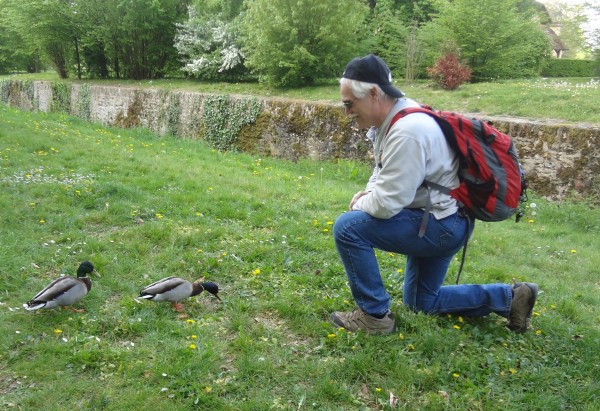
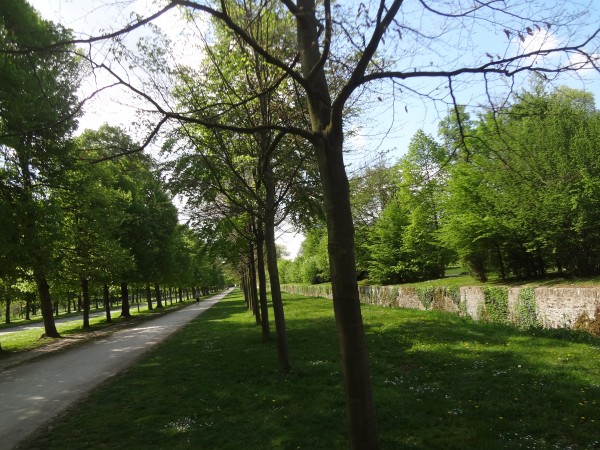
Tale
of two trees. On the left are the French trees
standing in perfect order on either side of the footpath.
On the other side of the moat are Marie Antoinette's trees
allowed to grow any way they wish as long as it wasn't side
by side.
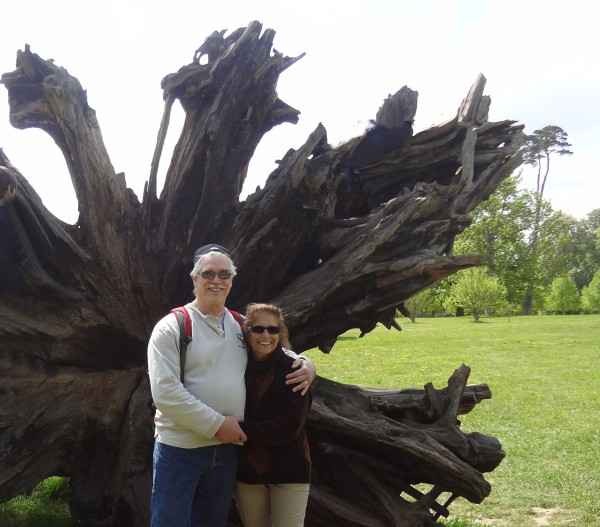
Costigan told a story. When Marie Antoinette's
favorite oak tree was blown down in a
storm, American school children heard about it and sent
the officials at Trianon a box of acorns as a sympathetic
gesture. French officials had the acorns eliminated
for fear they would contaminate French trees. Please
note I
have not been able to confirm this story on the Internet,
but you are welcome to try.
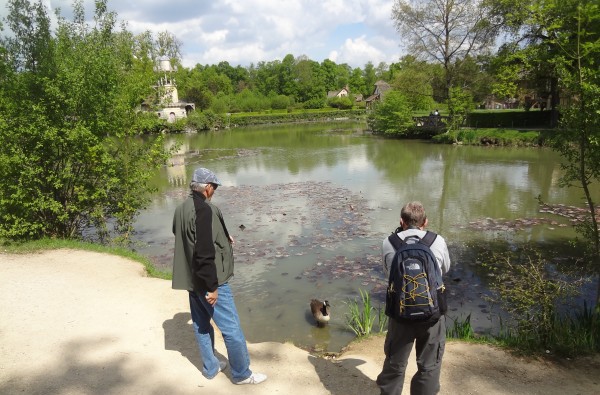
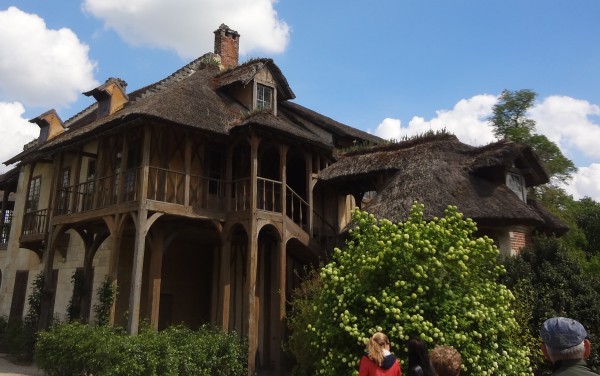
Antoinette would hide in this cottage, put on Austrian
peasant clothes and pretend to back in the Austrian province
of Tyrol. She may have been a lightweight, but she
never deserved the ugliness she was subjected to by the
French people.
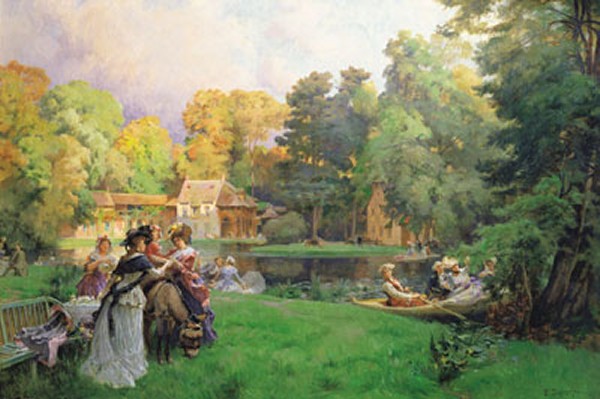 |
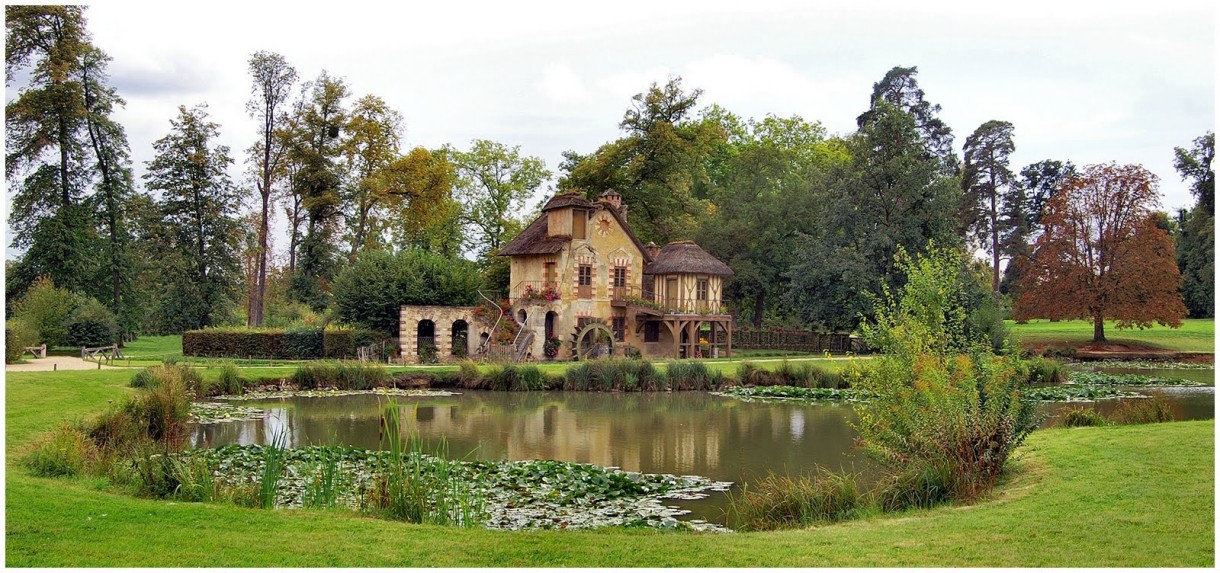 |
| |
|
The
Grand Canal
|
|
|
|
Eventually
Costigan said it was time to go. Neither Marla nor I wanted
to leave this amazing place. Petite Trianon
felt like a sanctuary. It was obvious why Marie
Antoinette chose to spend as much time there as she possibly
could.
Almost against
our will, we forced ourselves back on our bikes.
To my surprise, our next stop was even better!
The highlight of the day turned out to be the picnic.
Costigan had us ride our bikes through the forest to the
Grand Canal. Our picnic spot gave us a perfect view of two
giant canals that intersected to form what seemed to be a
cross.
I noticed there
were many small gondola-style rowing boats with couples
taking a romantic spin out on the water. As Costigan
confirmed, these boats had been rented on the grounds. I
wanted to rent one of those boats so badly!
In front were the crossing canals, behind us I noticed a
dense forest full of joggers and cyclists using the many
trails. What a thrill it must be for the citizens of
Versailles to come and exercise in this heavenly place.
Costigan made me laugh when he said in the winter those
canals ice over. Hundreds of people can be seen skating
across the frozen water. What a spectacle that must be!
Well, now it was Omar Khayyam time. Back a million eons ago
when I was a hippie in college with hair down to my
shoulders, a highly romantic phrase from Khayyam's Rubiayat
was in vogue… "a jug of wine, a loaf of bread, and thou."
As Marla and I found an isolated corner of grass in the
shade, we took our feast out of the bike basket. A bottle of
Chardonnay, brie cheese, green grapes, and several pastries
and the gorgeous setting imaginable made for a perfect
afternoon picnic. We even had a soft breeze to cool us.
While I ate my grapes and cheese and sipped my wine (Marla
was more interested in the pastries), I wondered why she and
I don't do this more often. So I asked her what she thought.
Marla replied,
"Three reasons. Heat, bugs, and no place remotely as
beautiful as this place back in Houston."
I winced at her reply. Ouch. I was forced to admit she had a
good point.
After our meal, we made a head rest out of my jacket and
laid back to watch the boats on the two canals. Now a series
of swans came floating by, so I tossed them some bread and
watched them dive for it.
Now was the time. I put my arm around Marla and hugged her.
I made a point to thank her for both the trip and for today.
My heart was full of gratitude. Not only had she planned
this incredible trip to France, she had discovered this bike
tour that had brought me such infinite pleasure today.
And
now she was here beside me to help me enjoy one of the
happiest days of my life.
Our friendship means so much to be on these trips. I knew
that this moment would never have been as special if I had
not had Marla alongside.
|
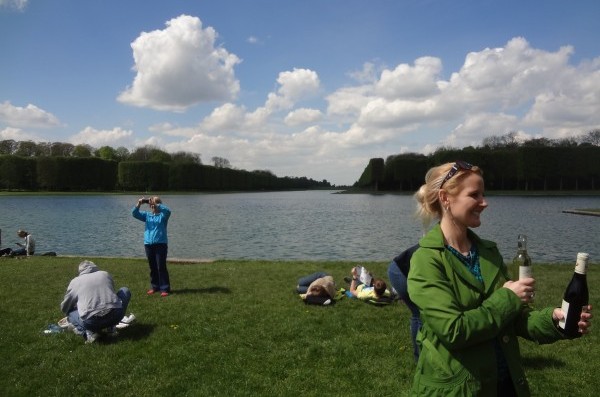
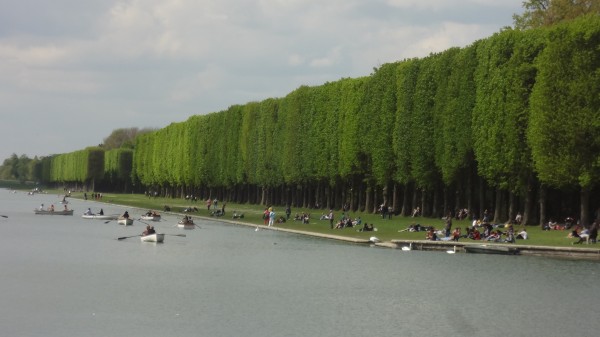
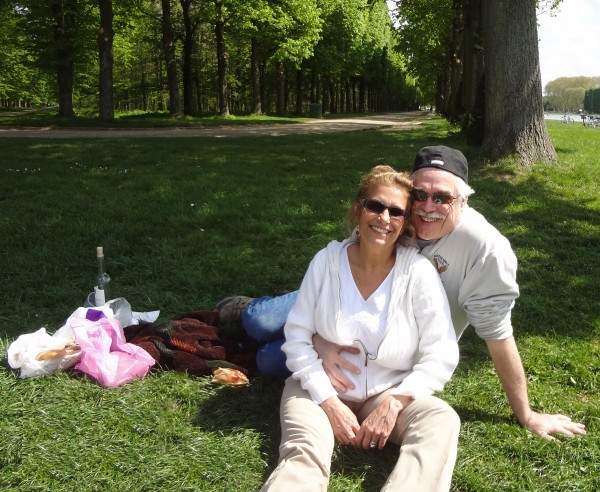
A jug of
wine, a loaf of wine, and thee
|
As for
Versailles, I think the only way to appreciate just how vast
this estate is would be to view it from the sky. This
Google Earth picture shows the unusual cross shape of the
canals.
The picture also
gives us a perspective on the immense size of the Grand
Canals.
As for Marie
Antoinette's Trianon, it is located a mile and a
quarter from the Palace of Versailles.
It is said that
Peter the Great modeled his Peterhof estate on
Versailles after visiting it. My only regret from
visiting Peterhof is that they didn't allow us to
walk the grounds like they did in France.
I have never
seen a more beautifully landscaped place than Versailles.
It was simply wonderful.
|
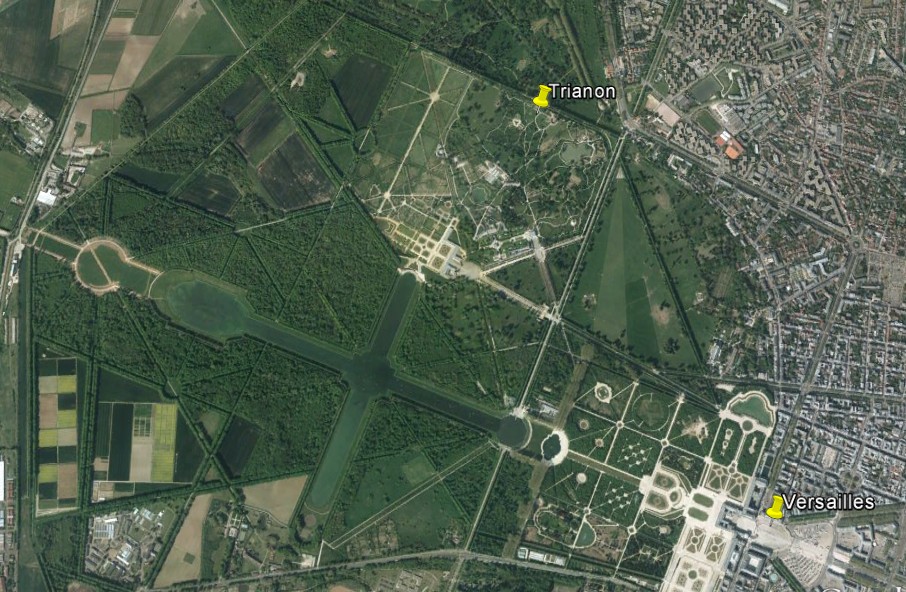 |
| |
|

The
Palace of Versailles is quite spectacular. The
Hall
of Mirrors
above is one of the most famous rooms in the world.
Countless important events have taken place here such as
crowning of the German Emperor in 1871 and the Treaty of
Versailles that ended World War I. From what I gather,
both events were closely linked. The first event was
held to irritate the French.
The
choice of to use this room to end World War I was no
accident. The second event was held as payback to the
Germans.
|
| |
|
My day at
Versailles was my favorite moment of our 2014 Rhone River
Cruise, but it was hardly the only adventure.
The day prior
had been exquisite in its own way with a walk through the
statue-filled Garden of the Tuilleries, a five hour stroll
through the Louvre Museum, and a two-hour ride on a Hop
On-Hop Off Bus that showed us the endless highlights of
Paris.
Those Hop On buses are fun. I laughed as my friend Eileen
told me at breakfast how much she had enjoyed the Hop On
bus. Eileen said she had done four different routes one the
first day! And then she went back and did them again the
second day as well.
There's never enough time for a place like Paris. Marla had
spent the past four years moaning about how we missed the
Louvre on our first trip to France in 2010. So when Marla's
friend Fran told her about seeing all the impressionist
paintings in another museum titled Musee d'Orsay - Manet,
Monet, Degas, Van Gogh - Marla immediately went nuts with
envy. Overwhelmed with disappointment, I could see her brain
calculating how long she had to wait until her next trip to
Paris.
You may have noticed I haven't said a word about our river
cruise. Don't for a moment read anything negative into that.
It only means I haven't gotten to it yet.
As I said earlier, this river cruise along the Rhône and
Saône rivers delivered everything exactly as promised.
For seven days,
Marla and I sat on the deck viewing the tree-lined banks of
the rivers, the magnificent Alps in the distance, the
rolling hills, vineyards, chateaus, cathedrals, ancient
castles, modern million-dollar estates… there was not a
single stretch of the entire seven day span of the two
rivers that was not beautiful.
The history of
France was fascinating.
I have to admit I developed a profound appreciation for the
Roman Empire on this trip. Of course the Romans were cruel
despots who enslaved countless millions to build their
temples and die in their arenas. And yet at the same time,
their engineering ability was out of this world! In every
town I visited, I saw fabulous structures those Roman
engineers had built two thousand years ago that were not
only still standing, some like the arena in Arles or the
theater in Vienne were still being used!
I also developed
a healthy respect for the Catholic Church. All I ever hear
about in America are the scandals. Not so in France. France
allowed me to see first-hand the importance of the church.
France is a very religious country with a deep love for the
Church. I came away with a real appreciation for the
civilizing influence of the Church throughout the country. I
have to believe France became a nation that valued laws and
knowledge way in advance of its neighbors thanks to the
Roman presence, then to the presence of the Roman Catholic
Church that followed.
Avignon… what a city! Lyon… what a city!
There was so
much that happened, so much I learned about France. And of
course there were friendships. We had a table of friends at
dinner every night. We drank wine, we toasted, we solved
family problems, we hugged, we laughed, you name it. Not one
night went by without someone crying of happiness or
release.
Marla gave me one of my favorite moments at dinner. She had
deprived herself of bread for an entire year just so she
could eat all the bread and all the croissants she wanted on
this trip WITHOUT GUILT.
Sure enough, I
had to grin on the first night when Marla emptied the bread
basket, added butter, and began eating. Without realizing,
she started to moan with pleasure. Mmmmm!! It got so bad I
had to elbow the girl when people started looking over.
Is it possible to have too much fun??
Indeed, this was the first cruise I have ever been on where
I had to hide in my room because I could not take ANY MORE
FUN! On the last full day of the trip, while Marla and the
Gang headed over to a lovely abbey in the countryside, I
simply stayed in bed and played computer chess. I just
couldn't take it anymore. I was actually too overwhelmed by
all the events of the trip to see something new that day.
Let me add that no trip has ever taken me longer to bounce
back from. It took me an entire week after coming home to
finally discover a hop in my step. Up till then, I had been
going through the motions. This trip completely wore me out…
physically, mentally, emotionally.
So is this a criticism of the trip? Absolutely not. Marla's
Rhone River Cruise was a slam dunk success of the first
magnitude.
Mind you, not one thing went wrong. Nothing. I didn't lose a
thing, I didn't make any mistakes, I didn't do or say
anything stupid. In addition, Marla's organization was so
complete that there was not a single transportation snafu.
My exhaustion had nothing to do with problems. I just ran
out of steam, that's all. I never realized till this trip
that could actually be is a "limit" to how much fun I can
have on a trip. Once I exceeded my fun limit, I had to shut
down. Please, no more fun today! Don't torture me with any
more fun; I can't take it!
Of course no one has given me a bit of sympathy. Not a
single person back here in Houston seems to understand that
a person can overdose on "fun".
And you know what? We are going to do it all again same time
next year on Germany's
2015
Rhine River Cruise.
Truthfully, I
have never anticipated a trip with more excitement than this
one… The Swiss Alps, the mighty Rhine River, the Black
Forest, the beautiful French town of Strasbourg, Castles on
the Rhine, the ominous Rhine Gorge with mist and Lorelei
mermaids, Beerfest and Polka Dancing to German Oompah bands
in Rudesheim, plus windmills, tulips and canals in
Amsterdam.
Normally, I
would say "gosh, I can't wait!" But in this case, I am
secretly happy I have a full year to recover from the Rhone
River Cruise. My only fear is that this trip has the
terrifying threat of "fun exhaustion" written over it as
well.
My body and spirit simply cannot handle this much exquisite
fun without a serious rest in between.
Rick Archer
May 2014
|
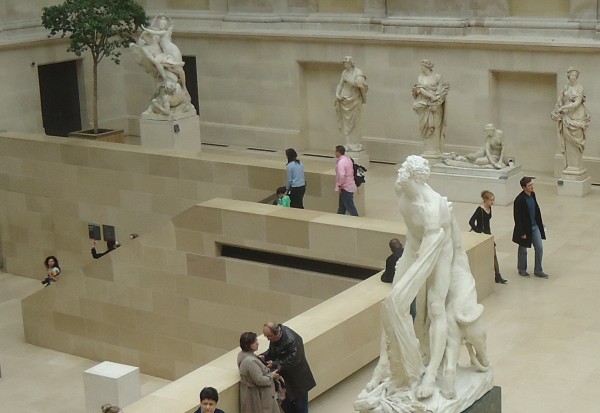
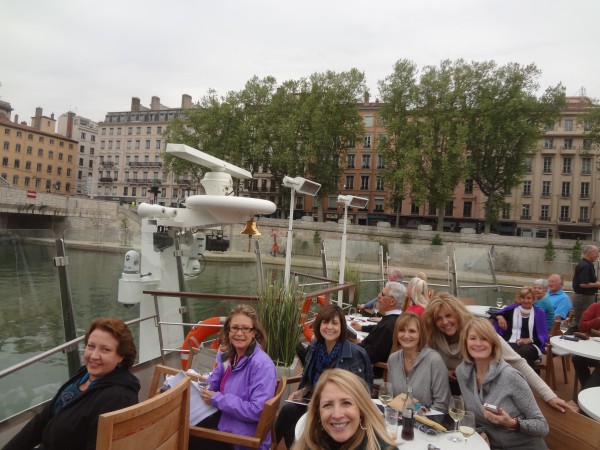
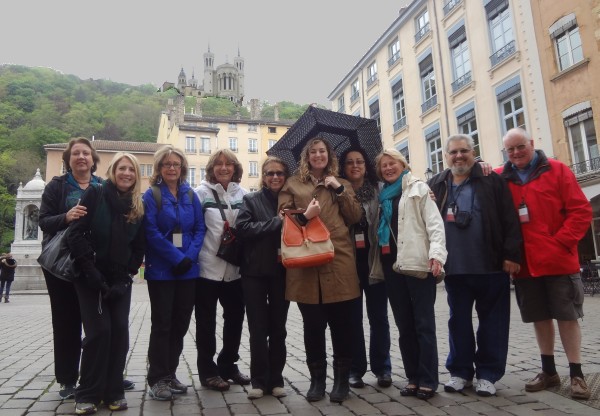

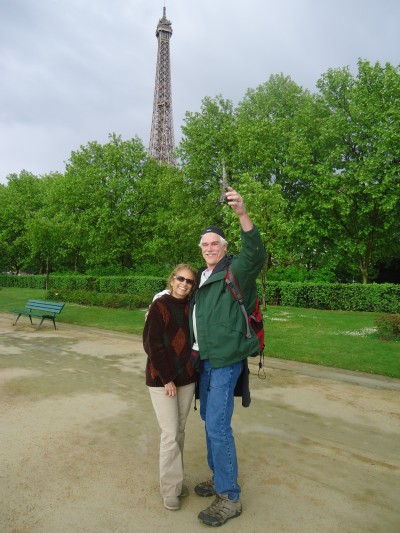
|
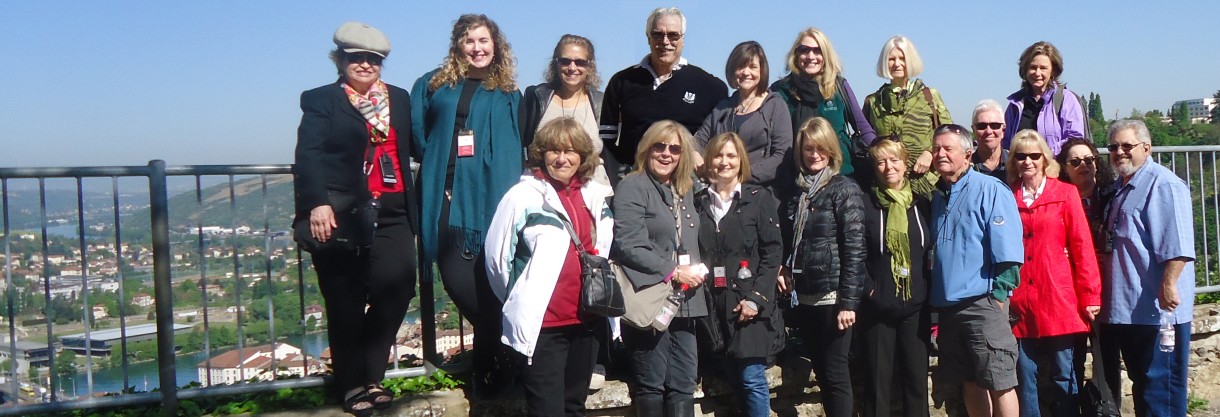
On top of
the world in Vienne. Velma, Emily, Marla, Rick, Susanne,
Deanne, Judy Bonnie
Eileen, Ann, Linda, Paula, Meredith, Tom, Mike, Sarah, Roz,
Larry |
|
The River
Cruise Experience
|
Written by Rick Archer
May 2013
When
Marla told me she was thinking about scheduling our first-ever river cruise,
I thought she was reading my mind. I had recently
caught myself drooling with envy every time the Viking River Cruise
ad flashed on the TV screen.
I laughed when Marla admitted that ad had the
exact same effect on her.
With our first-ever River
Cruise scheduled to take place one year from now, I was curious to
learn about some of the differences between an ocean cruise and a
river cruise.
So I asked a friend who had
been on a river cruise before to explain the difference.
|
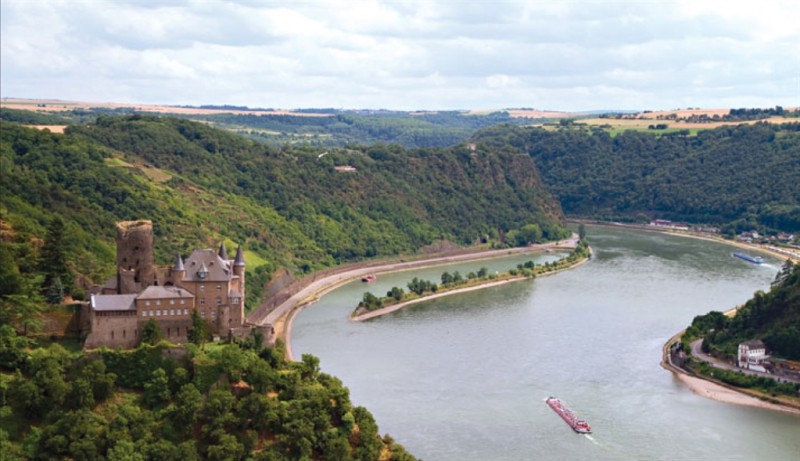 |
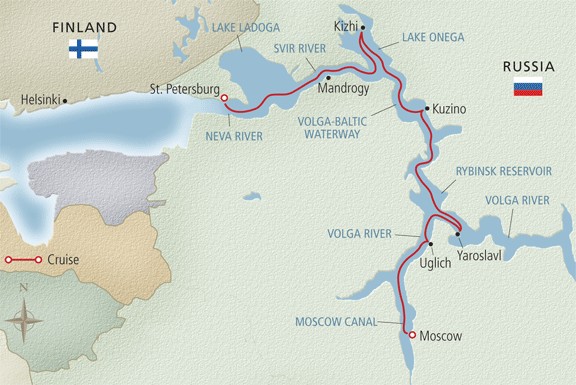
Russell's 2012
River Cruise to Russia
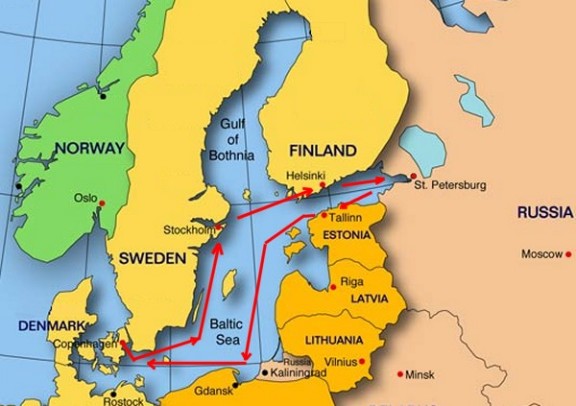
Rick's 2012 Ocean
Cruise to Russia |
The Tale of Two Maps
By
chance, my friend Russell Orr had visited Russia last year about the same
time that Marla and I took our
Russia 2012
Cruise.
Naturally every time I saw
Russell, I would
ask him about the river cruise he took to
Russia.
Truth be told, as we compared notes, I found myself having a hard
time controlling my envy.
Please
don't misunderstand. My cruise to Russia was an unforgettable
highlight tour. In particular, I loved Stockholm and I loved
Tallinn. It was a great trip.
But
what I really wanted to do was to see more of St. Petersburg. I
spent nine hours in St. Petersburg. Russell spent three days.
I spent no time in Moscow. Russell spent three days.
Need I
say more??
An
ocean cruise gives you a wonderful look at the Big Picture, but will
frustrate you if there's a place you prefer to concentrate on.
A river cruise allows a person the luxury to focus directly on a
region.
One
evening I asked Russell to talk about what it is like to be on one
of the long boats they use on the river. Russell's eyes lit
up like Christmas candles. I could see
the delight in his big smile.
Russell started his reply
by saying I could not even begin to imagine the joy of his trip.
Russell grinned as a memory flashed
across his mind and then he began to tell me a
story. I may get the details a little mixed up,
but here is the gist of it.
Russell said his favorite
moment was
a particular "enchanted evening"
spent dancing with his beautiful lady
friend Pat.
Russell explained that the ship
had hired some Russian college students
during the summer to help run the show.
This was a great way for the young people to pay
for their education.
Russell said he had no idea "Russians" could be so friendly.
He
concluded that unlike the dour old-timers who still bear the
scars of the Communist era, the young actually know how to laugh and
smile.
|
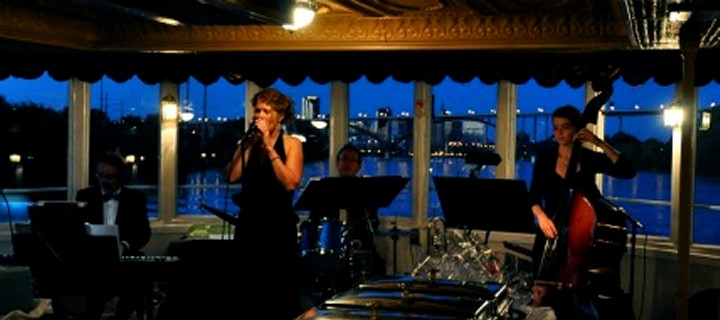 |
Russell said among the
enthusiastic college kids were two musicians who played every
instrument under the sun.
Each night the
duo would play their music
and each night Russell and Pat would get out and dance under the
stars. Russell added they were the only guests who actually danced.
Apparently there was a closed
circuit camera that was focused on the music area. This camera sent
a feed to every cabin so people could listen to the music in their
rooms if they wanted to.
|
Russell explained that the dance floor was situated right in front
of the musicians and their array of instruments. Apparently the camera's eye included
both the musicians and the dance floor as well.
One night as
Russell and Pat danced the night away, the camera caught their every
move… and neither of them had any idea they were putting on an
90 minute show for the
entire ship!
The next morning one
guest after another came by to thank them for providing such
wonderful entertainment! In fact, one guest
asked Russell if they were planning to do it again. They were
the hit of the cruise!
I am sure Russell and Pat were a little
embarrassed that their special moment was captured on
camera, but deep down I think they were tickled by the praise as
well. I asked Russell if the camera caught any smooching. He
grinned and blushed a little, then politely declined to answer.
I probably have no
business sharing such an intimate story, but it is so cute that I
could not help myself. 'Tis better to
share and ask forgiveness later!!
I have no doubt that
Russell and Pat made every guest on that ship wish they could dance
too. I always tell men they should learn the fine art of romantic
dancing. Chances like this river cruise come along too rarely in
life as it is. Why not make the moment perfect?
I
always say that Slow Dance and Romance go hand in hand.
Indeed, something pretty special happened on that river cruise. When
the couple returned to Houston, Russell asked her to marry him...
and Pat said yes.
|
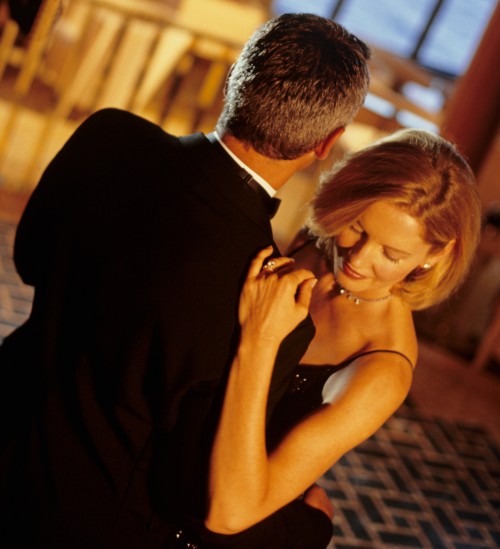 |
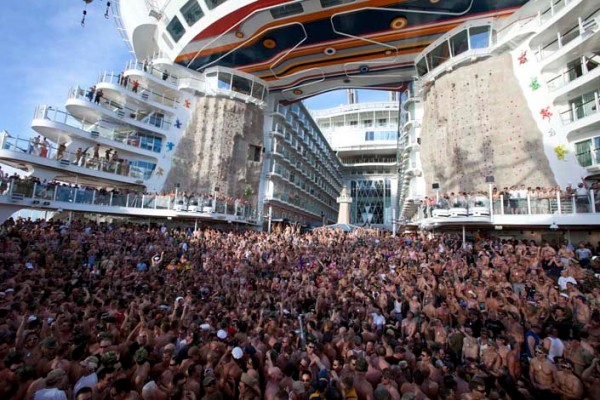
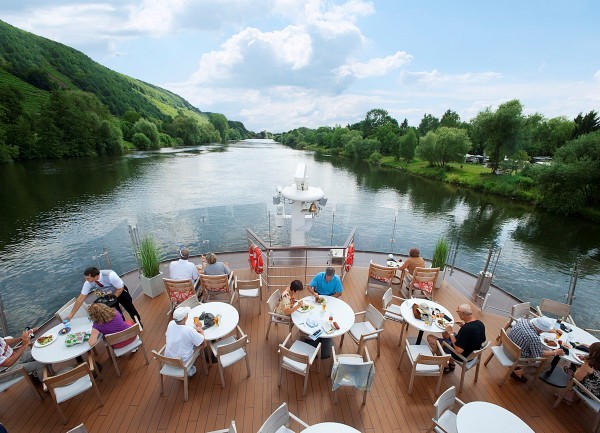 |
A Very Select Group
From what I gather, the
river cruise adventure has many features that separate it from our
ocean experience. Just for starters, you are swapping
a massive ship
that carries anywhere from 3,000
to 6,000 passengers for a
slender ship that
carries a maximum of 190 very privileged
guests.
If you
are comfortable with crowds and don't mind waiting in lines, then
trips on monster ships such as the one pictured might be fun.
However, I will confess that at my age I feel more at ease with the
intimate setting.
I
like a small group. I get to see these
same people every day and I
have an entire week to get to know them. I might
even make a friend for life with an opportunity like this.
They say a cruise ship is
like a floating hotel. I say a river boat is closer to a floating
inn. Or maybe a very large yacht!
Another major difference between a river cruise and an ocean cruise
is the view.
On an
ocean cruise, you spend countless hours staring out at the sea.
For people stuck in the city for most of their lives, this is a
welcome sight. That said, seeing the same vista day in and day
out grows old very quickly. You soon find yourself glancing at
the water from time to time, but that's about it.
On a
river cruise, there is actually something to look at it.
You will
literally float
through the most beautiful countryside imaginable.
You will gasp at one precious sight after another.
Not
only can you dine out on deck, every cabin has a river
view. Be it forests and vineyards,
farms and chateaus,
there will be always be something new to capture your fascination.
No matter where you are on the long ship, you can just sit
there watching the world go by. Sip your
wine and enjoy one of the happiest moments of your life as
rolling hills and
the ever-present green countryside
moves
across your eyes in an endless tableau
of pastoral beauty.
|
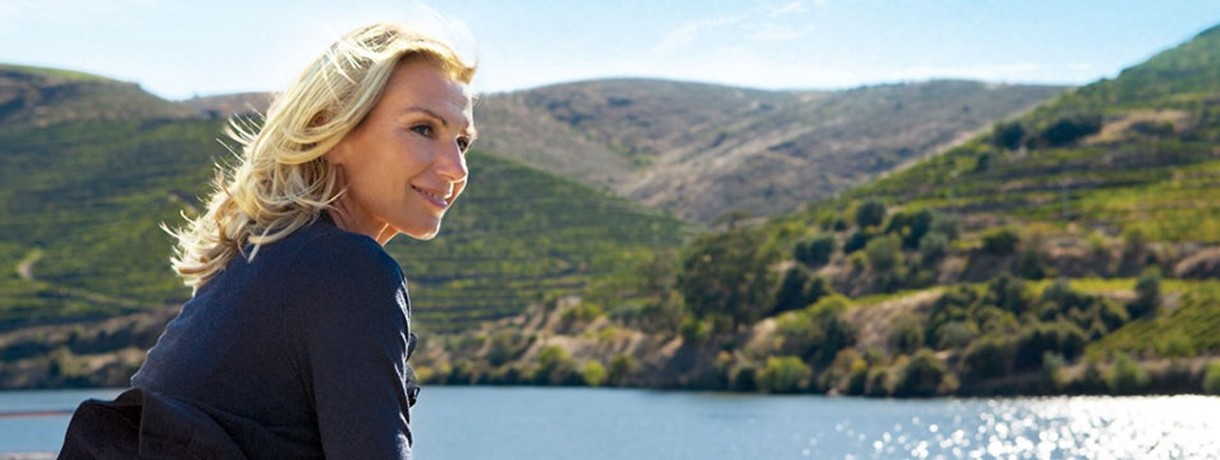 |
Tender Mercies
There are no days at sea
when you sail down the river. Each day
brings you to one
quaint town or precious little village after another.
Each day takes you to a new adventure.
The
Rhône River has served as the "Mississippi" of France for centuries.
Local farmers have used the river to transport their goods to market
for centuries. Furthermore, ships from all the Mediterranean
countries have long used its waters to trade with Northern France.
Consequently, there are existing docks at every town where our
longboat can pull up and drop you off instantly.
At each stop the
boat will dock
right in the center of the town.
It takes all of one minute to get
on or off the ship. You can stroll through the town in the morning,
come back to the ship for lunch, then head back out and explore some
more. You come and go as
you please. This is the right way to see the world!
|
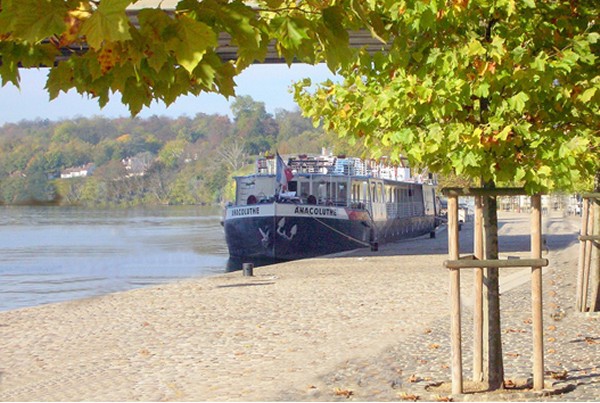 |
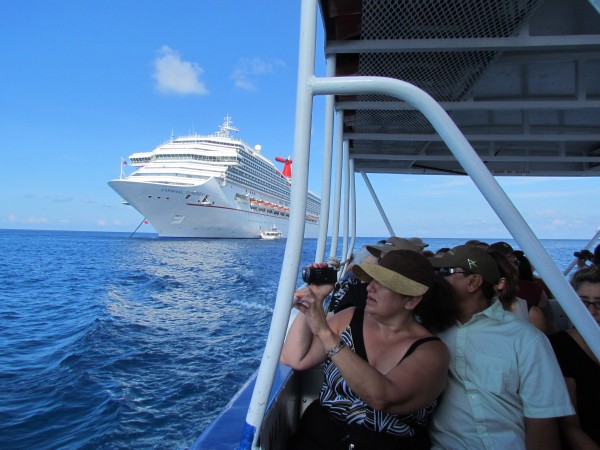 |
Now compare that to the
tedious "tendering" process common to the large cruise ships.
On every
other trip I have taken, there is at least
one port that requires a smaller boat known as a "tender" to ferry
you onshore.
If you are given seven
hours at a port, two of those hours are completely wasted.
For
example, we recently used a tender in Belize on our Mariner 2013
trip. Our ship was parked over a mile off shore. I
estimate we burned at least an hour and a half traveling back and
forth.
We
always use a tender at Cayman. The huge lines mean at least
one hour in each direction.
Tendering means you get
to wait in line for half an hour to get on the boat. Then you waste
another half hour getting there to the island.
Then you have to turn around
and do it again in the evening.
There is no time wasted
on a river cruise. You don't spend half your trip at sea
and you
don't spend half your day on a tender.
In fact, if you wish, on a
river cruise you can be busier with sightseeing than practically any
trip you have ever taken.
|
|
|
|
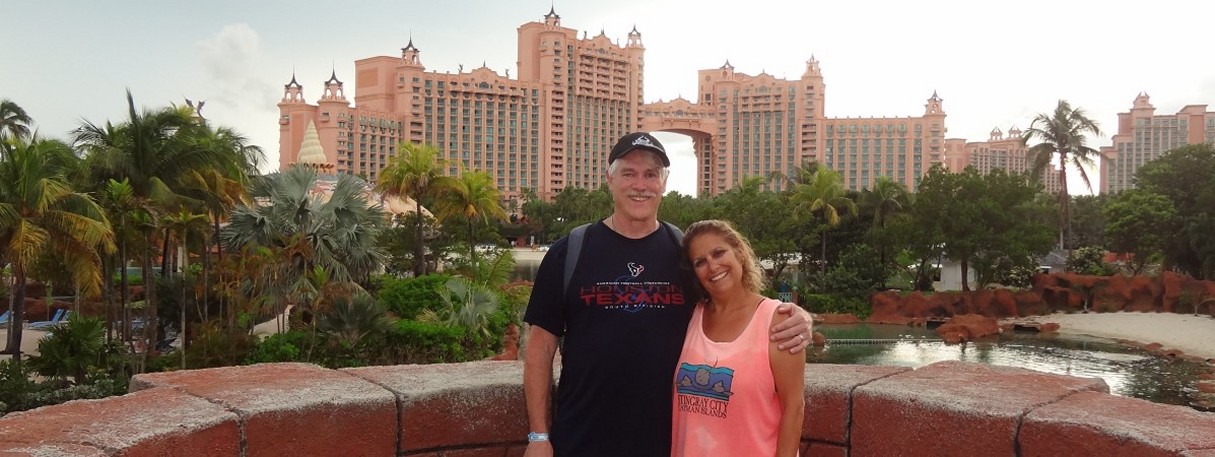 |
The Atlantis
Awakening
No one is going to deny a
river cruise is expensive. As with any premium adventure, you have
to pay a price for the privilege of having a
truly wonderful experience.
In
2010, I visited the water park at Atlantis in the Bahamas for the
first time. On that visit, I
made a very unusual discovery.
Prior
to the trip, I blanched when Marla said tickets were $130 for a
day's visit. That would $260 for the two of us. "No
way", I said. But Marla showed me the pictures and persuaded
me.
On the
night before our cruise ship stopped in Nassau, I asked several of
the passengers if they were going to visit Atlantis. Every
person said the same thing. "Nah, it's way too expensive."
I
estimate only a dozen people out of 200 guests went there that day.
That's a shame because
Marla and I ended having the time of our lives.
The rides were incredible and there were hardly any lines. The
place was not crowded at all.
Our
favorite ride was the Lazy River. We had so much fun, we
stayed in those tubes for nearly three hours. Marla and I were
alone 80% of the time. It was an incredible experience to have
this remarkable playground all to ourselves.
That's
when it dawned on me. You get what you pay for. Pay low
prices, get big crowds. Pay big prices, have more fun.
On a river cruise, you save time, you meet truly interesting people,
and you see the world in perhaps the grandest way possible.
St. Augustine famously
said, "The world is a book, and those who do not travel read only
one page."
During
the years I ran my dance studio, I completely ignored the rest of
the world. Then Marla introduced me to travel. On each
trip I learned a new reason why people value travel so much.
The
first time I saw Rome, suddenly the history of the Roman Empire came
alive. When I saw Turkey, I began to think of Noah's Ark and
the possibility the
Black Sea
and the melting waters of the Ice Age could explain the myth of the
great flood.
When I visited Scotland, I developed a superior
understanding of the struggle between the Scots and the English.
When I went on the Titanic Cruise, I got so deeply in touch with the
tragedy that I felt like I practically knew the people who died.
When I
saw Barcelona, I discovered just how beautiful a city can be.
When I saw the Panama Canal, I was incredulous at the magnificence
of the engineering accomplishment. Travel helps me learn so
much about things I never knew before.
Another quote about travel I like is from Mark Twain. "Travel
is fatal to prejudice, bigotry and narrow mindedness... Travel helps
us discover we are a family after all."
When I
visit other lands, I start to realize exactly what Twain meant.
Race, religion, ethnicity all begin to mean less. People all
want the same thing - peace, safety, health, prosperity. The
world becomes a much smaller place when you travel.
I am
63 as I write this story. If you are anywhere near my age,
then you understand that time grows more precious every day.
People my age don't have a lot of time to waste any more.
Why
waste time if you can afford not to??
Based on our Puritan
ethic, few of us allow ourselves the risk of high-priced luxury.
We have spent our entire lives denying ourselves the finer things in
life so we will have money at the end. But the cruelty of
aging is that despite our frugal ways, we have only a small ten year
window where we still have the health to see the world. Once our
health goes, travel will never be the same again.
Life
is for living, not passively sitting at home waiting for the end.
Some of you
might agree we have reached the point in
life where we have earned the right to pamper ourselves.
As they
say, there are no pockets in shrouds. You can't take it with
you.
|
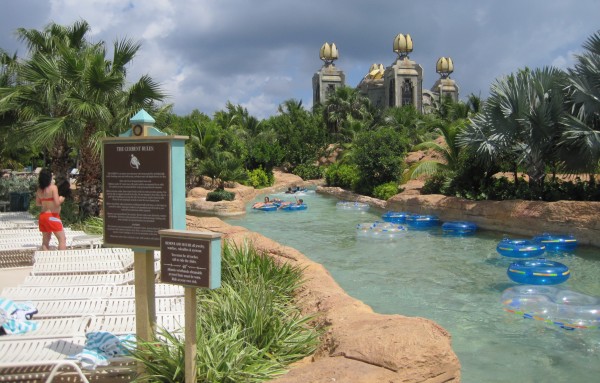
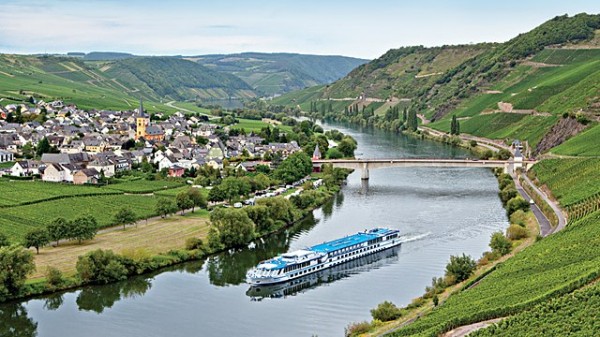
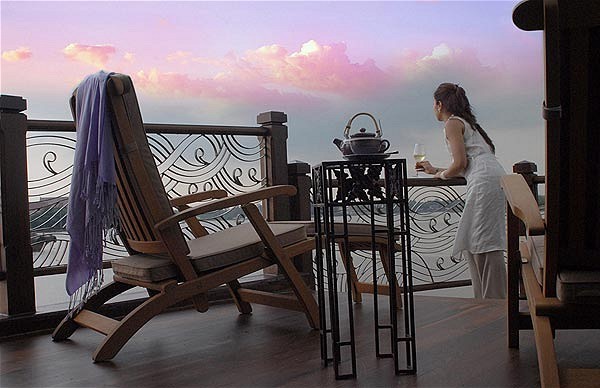
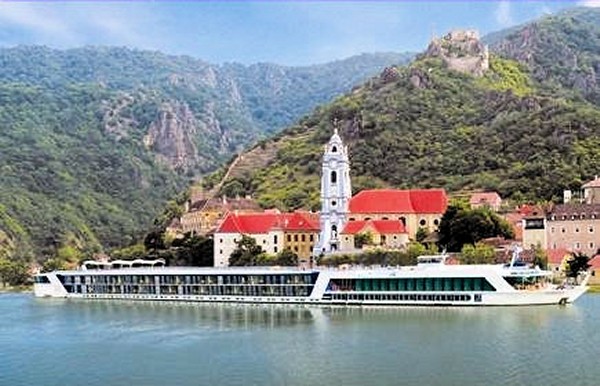 |
 |
Complimentary Wine
While
a river cruise is undeniably expensive, there are
savings in places we aren't accustomed to. There are
complimentary features that will certainly be appreciated.
For
example, there is complimentary wine served at every meal except
breakfast. You can have as many glasses of
wine as you wish (if you prefer
beer, soda or water, that is served free as well).
When Marla and I sailed
aboard the Azamara Journey for our Titanic cruise, the wine was
served throughout each meal.
Barriers fell quickly
thanks to the magic of the wine. Every night at dinner, the dining
room was animated with laughter and talk.
One of
my favorite moments on that trip came when my brilliant
friend Bob and I talked deep into the night. Bob
was an expert on the Titanic. Thanks to our
wine-loosened tongues, Bob opened up. He told me
stories and angles I never knew before. I learned more about the Titanic that night than I ever
thought possible. Bob and I became friends for
life. I could see Bob again and restart the conversation in a
flash. There is something about wine that
helps get the party started.
|
| |
A Cultural Experience
|
 |
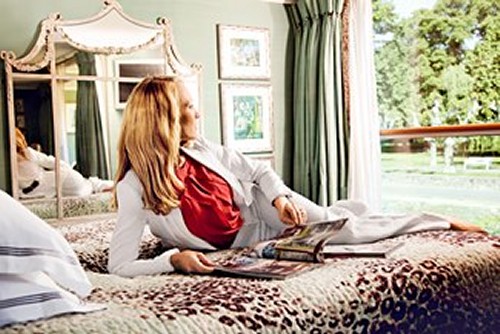 |
Complimentary Excursions
A river cruise differs
from an ocean cruise in that it gives you a fighting chance to
really explore.
Don't get me wrong… I
like ocean cruises. But if there is one downside, it is the
superficial treatment that each port receives. A river cruise
differs from an ocean cruise in that it gives you
enough time
to walk around and learn.
Like my trip to
Paris on
our Oslo 2010 cruise, there simply wasn't enough time to even begin
to see the city. We had five hours total to explore. By the time
we reached the Louvre, we didn't have enough time left to go in.
We just stared at the windows of the most famous museum in the world
as I screamed with anguish. This isn't right!! And then it was
time to head back to the bus.
|
|
A
river cruise wishes to educate its passengers about the region of
the trip. Therefore,
in addition to
free lectures
on board, each day there are several small-group
sightseeing excursions at EVERY port. You don't pay a dime.
The ship wants you to participate in the learning experience, so
these visits are complimentary.
More than likely, you
will meet a cheerful, outgoing guide who
will escort you through
each new town. In addition to being quite knowledgeable
about the region, the guide will learn your name,
where you are from and maybe even
your favorite type of wine.
Your
guide will quickly
assess your physical status and be able to give
advice on what
trips you can handle and what you might do if you need an
alternative.
Best of all,
our guide will help immerse
us deeply into the culture of the region.
France
is steeped in all sorts of fascinating ancient history. At different times
the Franks, the Gauls, the Greeks,
the Romans, the Vandals, the Goths, and the Moors have fought countless battles for control of this
precious
farmland.
The
area we will visit was featured in Julius Caesar's Gallia, a
book where he told the story of his conquest of Gaul in 58 BC.
You will be amused that in my 8th Grade Latin class, I actually
translated some passages from Caesar's Gallia. Believe it or not,
I still have the book!
"Gallia est provincia magna in Europa.
Gallia est patria agricolarum. Puellae silvas Galliae
amant."
That
was from Chapter One. I bet you can translate it...
"Gaul is a large province in Europe.
Gaul is farmland. Gaul has beautiful trees."
Many
of Caesar's battles were fought right along the Rhône River.
For that matter, his greatest victory, the Battle of Alesia,
was fought just a few miles north of Chalon where our trip ends.
|
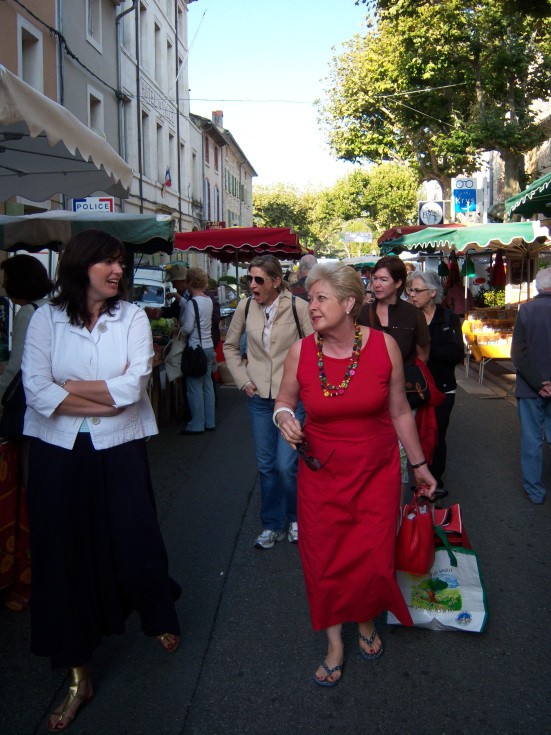 |
Avignon, one of our stops, was once the most powerful city in
Southern France. Avignon owes much of its importance to
Caesar. After Caesar conquered it, he made the town his
favorite outpost. Avignon was important because the Rhône was
the route taken by Mediterranean sailors wishing to trade with
Northern Europe. Control of the Rhône was vital to the
conquest of the entire region.
|
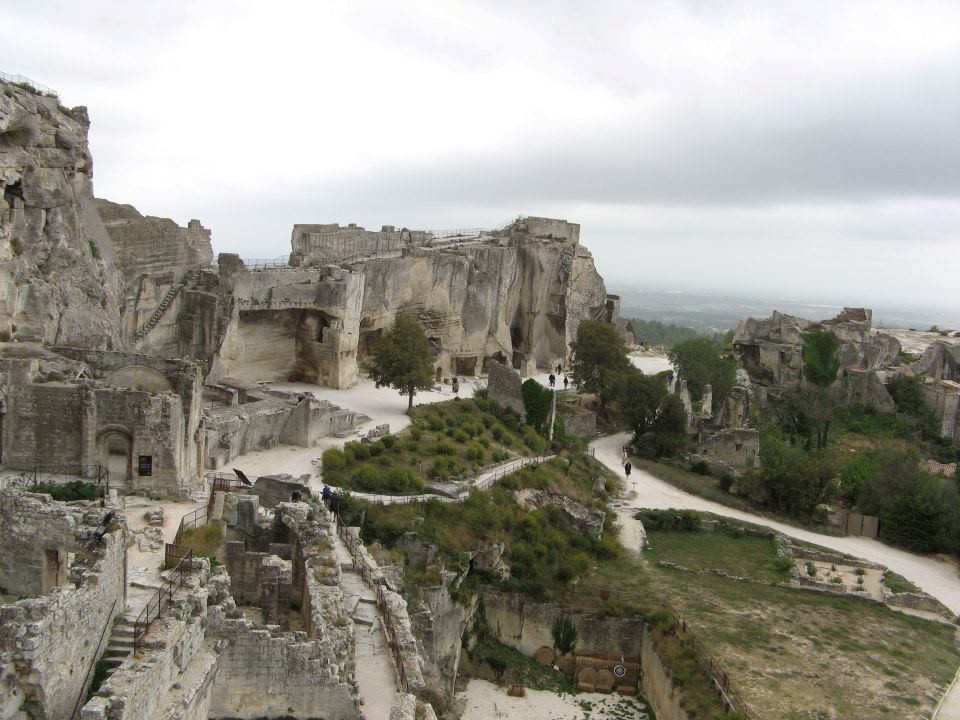 |
After
Caesar vanquished this city, he ordered an elaborate defense system
be built.
Why bother winning it if you aren't going to keep
it??
Today Avignon features some of the best preserved
ramparts (defensive walls) in France.
Here is a picture of the
Roman ruins in Avignon, France. These are some of the walls built to
defend the city.
We will get two chances
to visit these Roman ruins.
We will have the entire
afternoon of our first day to explore Avignon.
Then on Day Three of our
trip, we will visit Avignon again. On one of these days, we
will surely visit this amazing site.
|
Avignon has much more to
offer. For example, Avignon is called "The City of Popes".
Indeed, there is an amazing castle known as the
"Pope's Palace".
Most of us assume that
Italy has always had the most influence with the Catholic Church.
Not so. At one point, the French held sway. In 1305, a
deadlocked conclave finally elected Clement V, a Frenchman, as Pope.
Clement preferred to
remain in France, so he declined to move to Rome. In 1309 Clement
moved his court to the papal enclave at Avignon. It would remain
here for the next 67 years. This absence from Rome is sometimes
referred to as the "Babylonian Captivity".
A total of seven popes
reigned at Avignon; all were French, and they each increasingly fell
under the influence of the French Crown.
Finally, in 1376, new
Pope Gregory XI abandoned Avignon and moved his court back to Rome.
The Avignon Papacy was over.
Besides the castle, there's the
mysterious "Bridge to Nowhere". The reason the
bridge remains
incomplete is pretty amusing.
Apparently over
centuries, erosion has damaged the bridge. At this point, the
remaining part of the bridge has been restored, but now it is too
low for a river boat to go under... so rather than raise the bridge, they found it easier
to leave the job undone.
Tourism is more valuable to the
city than have a complete bridge. So many people are amused by
the unfinished bridge that it has become the international symbol of
the city.
You didn't know any of
this, did you? Neither did I. Travel is a dynamic form
of education.
|
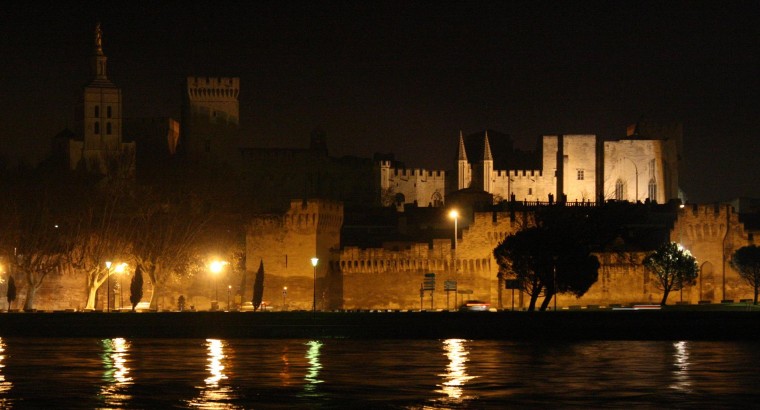
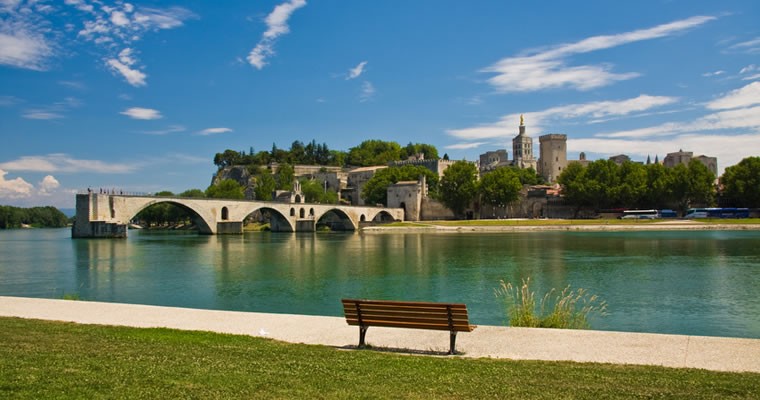 |
 |
I have been on 27 cruise
trips so far. Only twice have I been on a trip that attempted to teach me something
about where I was going. Both trips occurred last year.
The first was our visit to the
Panama
Canal. The other experience
was the
sad
Titanic Memorial
cruise that sailed to the spot where the Titanic sank.
Other than those two
trips, there has never
been any attempt whatsoever to educate the
passengers on the history and the culture of the places we visit.
Why cut into valuable bingo time?
That will change
dramatically on this river cruise.
Our trip through southern France promises to
offer one history lesson after another. We have already
discussed Avignon.
What
about Arles??
Arles is a quaint village that became the home of
Vincent Van Gogh for about a year and a half towards the end of his
life (1888-1889).
A
deeply disturbed man, Van Gogh began a steady descent into madness
during his time here. And yet remarkably, Van Gogh was very
prolific in his artwork. During our visit to Arles, you
could easily learn more about Vincent Van Gogh than you ever
imagined... or maybe even wanted to know.
For example, you will discover this is the town
where he cut off his own ear.
|
| |
|
 |
|
France - A World Leader in Art, Science,
Fashion and Culture
|
France has long been
Europe's epicenter of art, science, philosophy,
fashion and culture.
This
trip is so different that you
will have the chance to actually meet the French people in a way
that allows for the exchange of ideas and politics.
You won't have a tour
guide that you see today for the only time in your life. You will
actually get to know your guide on a personal basis. If you ask the right
questions, you may learn about France and its people in a way that
will far transcend any documentary or book you might read.
There have been rumors
over the years of animosity between the French and the Americans.
We have heard about French rudeness and disdain for our
politics.
As a result, we make fun
of the French. For example, 'Q: Why don't they have fireworks at
Euro Disney? A: Because every time they shoot them off, the French
try to surrender.'
Yes, it's true that the
USA saved France in both World War I and World War II. Good for
us! But please do not forget that America might not even exist
were it not for France.
|
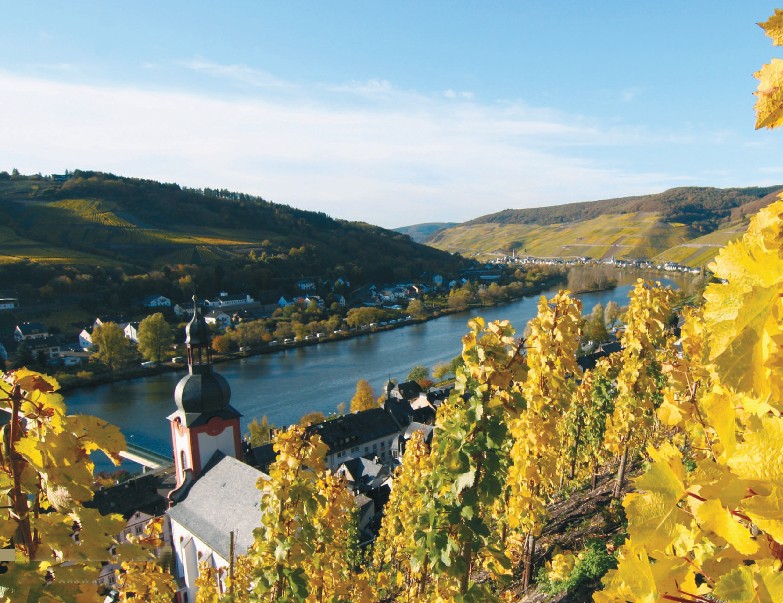 |
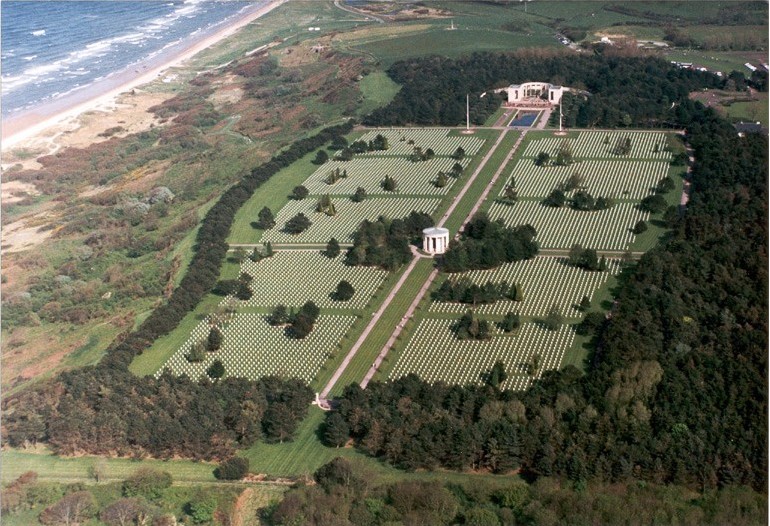 |
It was
France's intervention into the Revolutionary War that proved to be
the turning point. Without France, we might be the 50 Colonies
today and the Atlantic might still be known as "The Pond".
And I would like to add
that Omaha Beach of D-Day fame is practically hallowed ground to the
French. There is a sign at the national cemetery that says:
"This ground is
dedicated in perpetuity to the people of the United States of
America for the sacrifice its brave and noble fighting men gave to
our country."
There are 10,000 graves
at that cemetery. It is a very moving sight indeed.
I cannot even look at this picture without tears welling up. I
wish to add the French
consider it an honor and a sacred duty to guard and protect this
cherished property.
Furthermore,
every year French citizens in the Normandy area come out to
celebrate D-Day with American flags, parades and a huge outpouring
of gratitude. Americans are absolute heroes to these people.
|
To this day, there are people in
this area who witnessed the American bravery first-hand.
They watched in horror as young soldiers died
trying to liberate them. They wept as helpless soldiers were shot
down in their parachutes.
They peeked through their windows to see
brave men die in door to door fighting at St. Lo and Caen.
They even helped bury
the countless young men who died facing
deadly machine guns on the nearby beach
at Omaha.
|
There
is no 'French rudeness' in Normandy, only gratitude.
These people remember
what happened like it was yesterday. They saw people they had never
met before who sacrificed their lives to save them from Nazi
tyranny.
Their attitude is eternal:
We will never forget America.
This rumor about French
rudeness is a myth. Sure, if a tourist
behaves poorly, naturally they
can expect to be treated in kind. But that is the exception. In
this world of crazy senseless terrorism, France is thrilled to have
our friendship. France is one of America's truest allies.
I have visited France
twice. Wherever I have gone, Marla and I
have been treated with warmth and respect. All
I had to do
was wear a smile and I received
the kind of welcome accorded to a trusted friend
and neighbor.
Both times I found myself utterly charmed by
the beauty
and culture. I welcome the opportunity to learn more about this
amazing country.
|
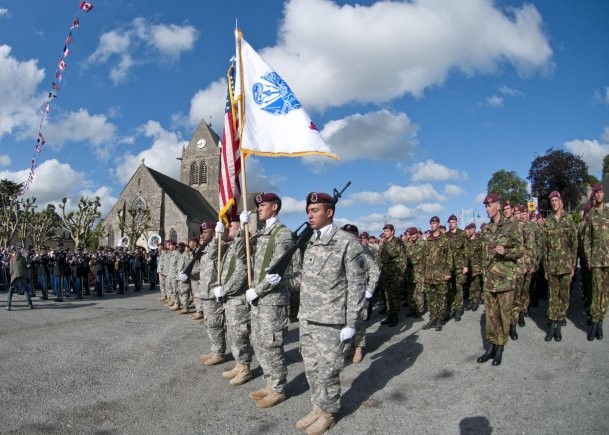 |
| |
|
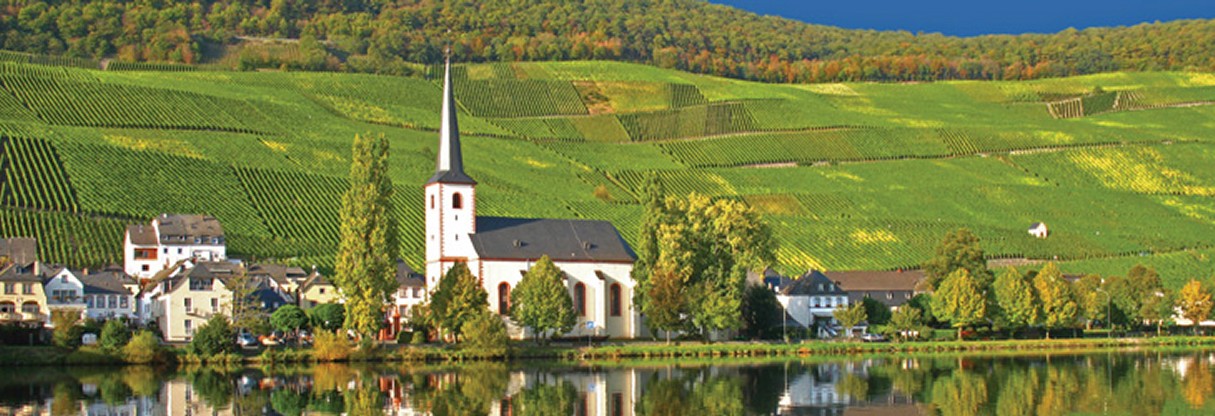 |
Parting Thoughts
There are other pleasant
surprises about this trip that might not have
occurred to you.
For example, there is no
such thing as "seasickness" on a long boat. The rivers are wide and
smooth. There is no such thing as waves and rapids. The ship
simply glides through the calm waters. If anything, the sailing has
less vibration than your average bus ride.
People
might read my story and conclude that I am knocking ocean cruises. There
is an old saying, "Don't bite the hand that feeds you".
I am not disrespecting ocean cruises. As Marla constantly points out, an ocean
cruise is an extremely safe and cost-effective way to see the world.
There
are times when an ocean cruise makes complete sense. For
example, a cruise is the perfect way to see the islands of Hawaii.
Ordinarily, to see all the islands of Hawaii would require daily
transfers from island to island and new hotels every night.
There would be considered time wasted.
Since
a
cruise ship is basically a floating hotel, it is perfect for Hawaii.
Likewise for Alaska and the United Kingdom. Using the water is
a very efficient way to visit these areas.
On the
other hand, there are places that are inaccessible by sea that can
be reached by river. Europe is the perfect example.
To me,
a river cruise is simply a more surgical form of an ocean cruise. For example, a
cruise ship might be able to go through the Panama Canal, but only a
longboat can sail the Rhine, the Danube and the Volga - and the
Rhone and the Seine of France.
Suddenly areas in Germany, Switzerland, Austria, and Hungary become
accessible to one of the most comfortable forms of transportation
imaginable. Who ever thought a cruise trip could take you to
the Alps? Castles and mountains and forests are magically
placed right at your fingertips.
A river cruise allows you
far more time to
explore a city or a town than you can ever
imagine. You have all morning and
all afternoon to tour the place. Your day can begin as
early as 6 am if you actually have the strength to get up
at that hour.
Here's
something else you may not have considered. Have you ever
thought of using a bike to expand your reach? Marla and I have
tried bicycles in several places. For example, we have used
bikes to explore Key West and Martha's Vineyard. Usually the
drawback is time. We wanted to use bikes in Maine's Acadia
National Park, but the stupid ship wasted so much of our time with
tendering that we had to scrap our plans.
Not so
on a river cruise. As we discovered in Key West, a bicycle is the
perfect way to explore a small town. Since the boat drops you
into the center of town, you can rent a bicycle in the plaza
and off you go. Imagine all the ground
you will cover. You can ride through
the streets of each village as far as your body will let you. Then when you get hungry,
head back to town,
drop the bike off right in front of the ship and hop back onboard.
How could that possibly be easier?
|
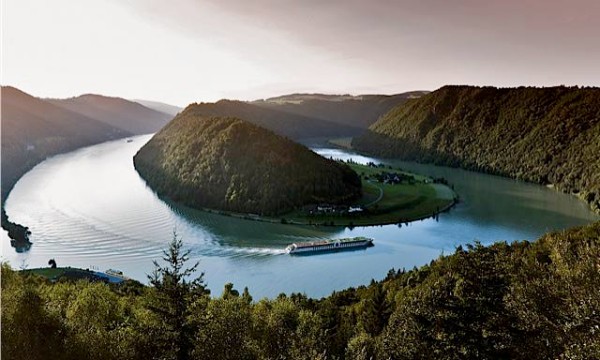
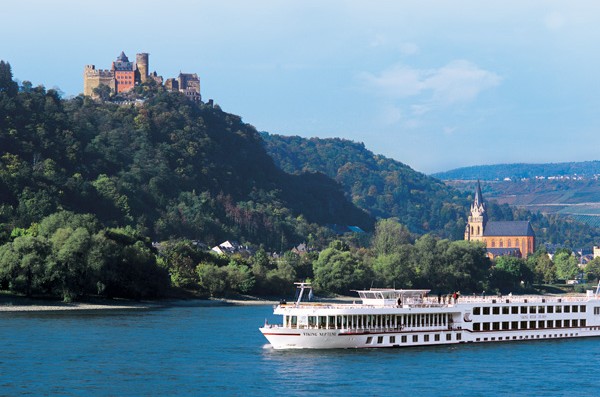
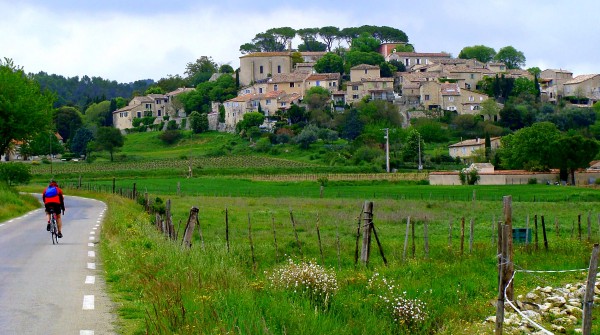 |
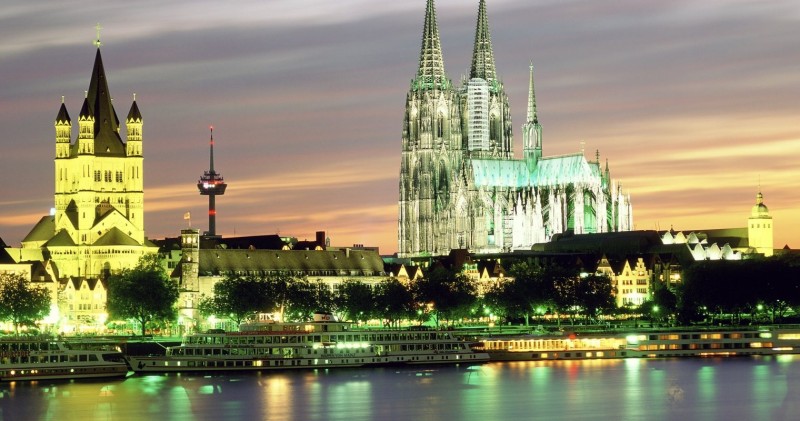 |
Better yet, you have the
evening too!
I suppose it does get
dark once in a while. Actually, now that I think of it, maybe even
once a day.
On an
ocean cruise, I don't even think about a port at night.
On a cruise ship,
typically you need to get back on board at 4 pm so the ship can sail
hundreds of miles to the next port.
Or perhaps we get back on
board early so the gambling casinos can begin to operate again.
Many times I have wished I could have dinner in town
at night and go to a nightclub
afterwards.
|
A good example would
have been St. Petersburg on our 2012 cruise to Russia.
My word, here we were six thousand miles from
home. How cool would it be to have dinner with Marla and our
friends in this amazing historic city? Let's see what Russian food
tastes like and see what Russian nightlife looks like.
However that never happened. At 4 pm we were
hurriedly whisked back on board the cruise ship. Poof!
It was here and now it is gone. One
brief taste of the city and we had to leave.
Wouldn't it have been nice to see a performance of the Russian
Ballet? On a river cruise, that's something you can actually
do.
Perhaps
in France we might take in a show
somewhere in town. Why not see the fabulous
French Can Can in person??
A river cruise is totally different. There is
no gambling, so the ship has no reason to rush you back on board.
Furthermore, the ship typically sails in the wee hours of the morning. After
all, the next stop is just down the river. The entire length of the
trip is only about 200 miles from start to finish. It is 124 miles
from Avignon to Lyon. It is 70 miles from Lyon to Chalon.
|
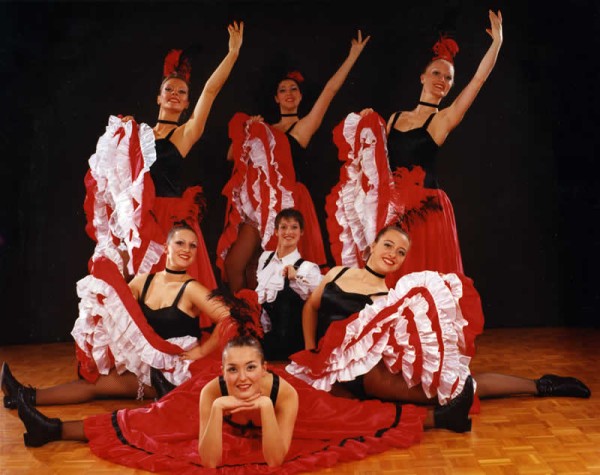 |
That averages out to
about 30 miles per night. Each night while we sleep, the staff
simply gets out their oars.
They sing 'row, row, row your boat
gently down the stream' in French as they merrily paddle away. Be careful not
to join in the singing… they might hand you a paddle.
The consequence of these
short distances is startling. Most evenings, the long ship stays
docked right at the pier so you can get off the ship at night and
have yet another adventure.
How about sipping some wine at a
sidewalk café with friends?
Imagine sitting there
under the stars with a breeze during a blissful April evening.
Maybe they will play French music while we sit. Will be the sad "La
Vie En Rose" sung by Edith Piaf?
Or will it be "La Marsellaise",
the French national song made famous in Casablanca
when the French loyalists defied the Nazi occupiers by singing over
the voices of the Germans?
|
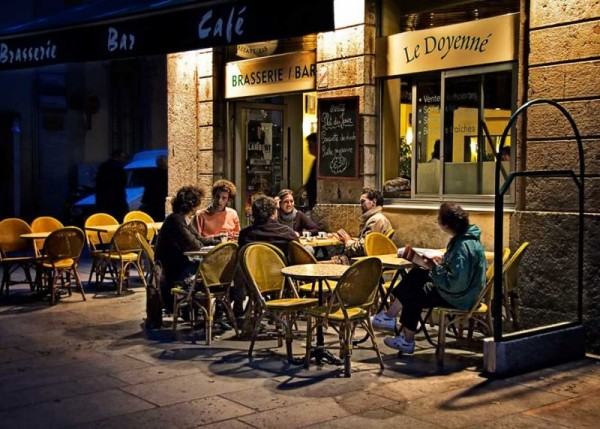 |
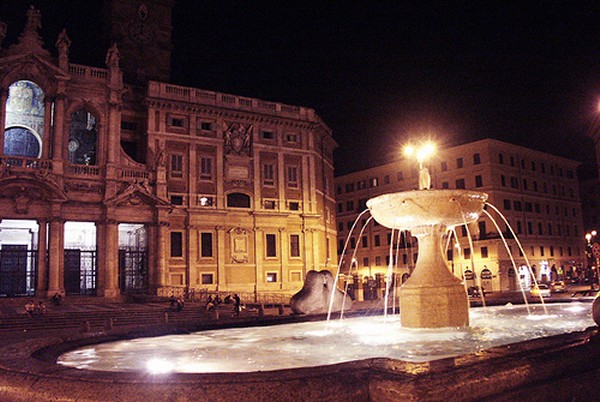 |
Or perhaps you might just spend your
evening strolling around ancient Roman
fountain under the moonlight in the town plaza.
It doesn't get any better than this.
Even the caliber of the
crew is different. As Russell explained to me, there is a warmth
and savoir faire to the college educated crew that transcends what
you might be used to on an ocean cruise.
At the max, the ship holds
190 guests. With a staff of 45 people, that creates a startling
ratio of one staff person to four guests. As a result, almost all
the crew learn your name, not just the waiter and the room
attendant. For that matter, maybe you will learn
some of their names too!
There are
many
advantages to this sort of intimacy. Each waiter and each bar
person will know what beverage you
desire before your lips
even move. All you have to do is whistle. Or use sign language if
you are too exhausted by all the fun to speak. I recommend
pointing, the Universal language.
|
If you don't want to go
into town, there is entertainment on board every evening.
Yes,
there is a dance floor. No, it isn't large, so yes, you better
brush up on your small floor ballroom dancing. I
definitely suggest you take a
refresher course on slow dancing. Incidentally, I happen to
know someone who is an expert at teaching small floor dancing in case you
need a few tips.
There is another
difference that might completely take you off guard. For example, I
was startled when Marla said there is no "Formal Night". Huh? I
didn't believe her, so I asked again. Marla shook her head with
confidence. She was sure of what she was talking about. No Formal
Night! What part of "NO" don't you get, Rick?
Marla said that on
a river cruise, comfort rules over style. The ship
deliberately cultivates a relaxed, resort-casual onboard atmosphere
- leave the formal wear at home.
I find that very
curious. If there is any place on earth where people collect who
can probably afford to look prosperous, I would guess it is on board
one of these long ships. And yet they de-emphasize the chance to
show off. Very interesting.
I suppose you can always
cheat if you want to. If you want to look really good, go for it.
They probably won't tell you to go back to your room and wear
something less flattering.
That said, be careful.
Don't overdo it. It's like a nudist colony… you're either in or
you're out. If I ain't looking good, then you better not be looking
good either. If anyone makes me look bad by over-dressing, I
promise to expose your fashion cruelty to the world through bad
photographs and snide comments.
Trust me, after I get through
doctoring your photo, you won't be smiling. Plus I will make you
look fat. That's a promise. Think Jabba the Pizza Hut.
|
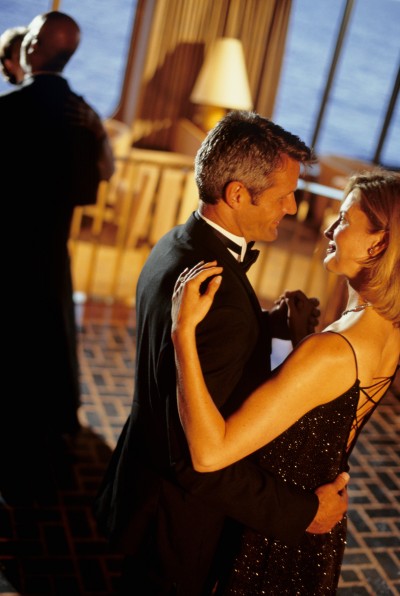 |
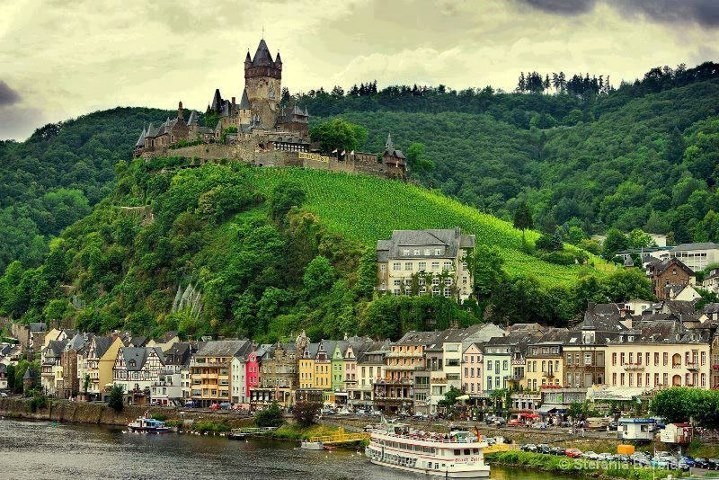 |
Speaking of pictures,
another thing you might find unusual is that no photographers will
interrupt your meal. No more quick gulps of food so you can force
the fake smile.
Another thing you will
surely miss are dancing waiters and loudspeaker announcements at
dinner. This absence worries me a great deal. Gosh, what we will
do? Without constant interruptions, we could be forced to develop
the long lost skills of witty dinnertime repartee.
How foreign is that? I
might have to practice ahead of time.
Speaking of the lost art
of communication, this trip promises to give people an
extended chance to get to get acquainted
on a much deeper level.
While
there is something to be said for the hot tub experience, I don't
think "deep conversation" is one of them. But if you are wandering
side by side through the streets of Lyon at night, you might
actually open up a little and bare your soul.
|
While we were on our
recent Mariner 2013 cruise, at dinner someone asked Marla what was
her favorite cruise. Her answer surprised me. She said, "Our river
cruise in 2014."
I immediately chided
her. "Marla, you can't pick a trip you have
never been on as
your favorite."
Marla responded in
typical Marla fashion, "Don't tell me what to think. This trip is
something I have dreamed about for a long time. I love everything
there is about this trip. If I say it is my favorite, then just
take what I say and accept it."
At this juncture, Marla
has already sold fifteen cabins
and has several inquiries to follow up on.
That is an amazing total when one realizes that Marla's group
promises to be somewhere between 16% to 25% of the entire passenger
list.
I say
this impressive number is a validation of Marla's work. This
is an expensive trip, no doubt. Therefore to have so many
people show this kind of confidence is quite an honor.
|
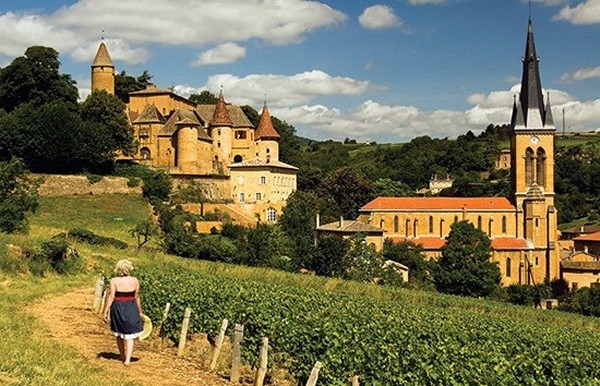 |
The
one thing I can promise is that
we will be a family.
You can count on that.
Marla and I had this
exact experience on the
2012 trip to Russia.
We
all shared so much warmth and laughter traveling together.
|
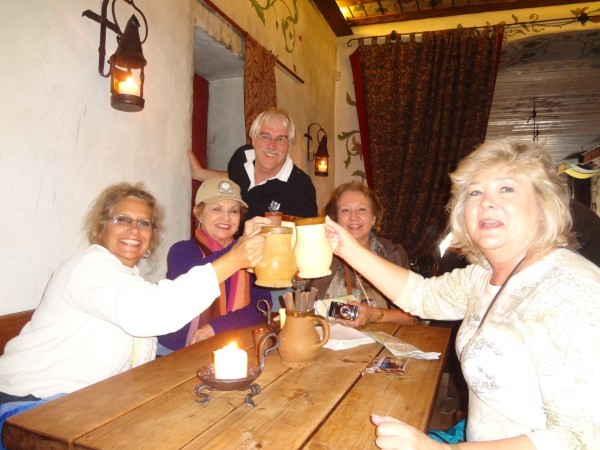 |
In Denmark, we stayed at the same hotel. It
was there that the girls surrounded Marla with reassurance during my
bizarre passport dilemma (yes, I actually lost my
passport!)
We
shared meals and went strolling through the magical Tivoli Gardens
together. In Finland, we shared lunch in the cellar of an intimate
countryside inn. In St. Petersburg, we drank vodka together in a
huge Russian dining hall. In Estonia, we drank
beer together
in a dark candlelit German biergarten.
We grew close. We had an
entire journey filled with special moments like these. We banded
together and became best friends in foreign lands.
Marla and I agreed the
friendship is what made the cruise to Russia special. That will
happen again on our river cruise. We will be side by side packing a
lifetime of memories into this journey. An ocean cruise is still a
wonderful way to develop friendships, but the river cruise
experience takes it to another level. This trip promises to be a
sublime experience indeed.
Rick Archer
June 2013
|
|
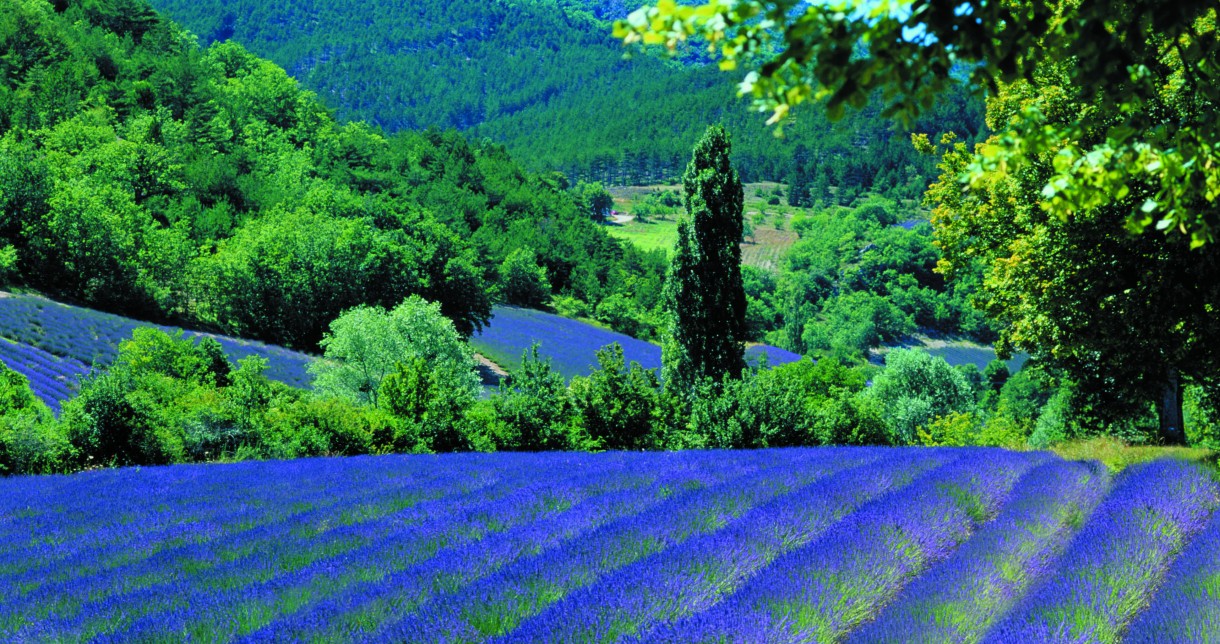
|